
2014-2015 First Regular Session | 70th General Assembly
Second Regular Session | 74th General Assembly
This website requires javascript to run optimally on computers, mobile devices, and screen readers. Please enable javascript for the best experience!

Visit and Learn
Request a tour.
Inquire below about booking a tour for your student group or take our virtual tour here .
Reservations are not needed for public tours.
The Colorado State Capitol field trip program is fully booked for the remainder of the 23/24 school year. You are able to book field trips up to one year in advance and doing so is strongly recommended. Self guided field trips are allowed, but will not include a trip to the dome observation area. Please email [email protected] for self guiding materials or with questions.
Capitol Tours
The Capitol is open Monday-Friday, 7:30-5:00. Free guided tours are available Monday-Friday on the hour between 10:00am-2:00pm. The Visitor Information Desk is open Monday-Friday, 9:00-3:00.
Capitol tours are limited to 30 people on a first come, first served basis. All tours begin at the Visitor Information Desk, north side, first floor.
SCHEDULED TOURS ARE SUBJECT TO CHANGE OR CANCELATION IN CONSIDERATION OF HEALTH AND SAFETY CONCERNS.
Capitol tours take about an hour and include a trip to the dome observation area. The dome is a 99 step climb above the 3rd floor and is accessible by stairs only. A closed-captioned video tour (near the third floor elevators) is available for visitors who are unable or do not wish to make the climb. Self-guided tours of the dome are not permitted .
Two entrances are available for Capitol visitors. You may enter the building on the north side (Colfax and Sherman Avenues), up the stairs, or use the ADA accessible ground level entrance (14th and Sherman Avenues), under the stairs.
All dates are subject to availability . If we are unable to schedule a tour for you, you are welcome to self-guide throughout the building but note that you will not be able to visit the dome on a self-guided tour.
We are unable to provide tours the following dates
Wednesday, May 22, 2024 - No Tours ( Capitol open for self-guided tours only. Mr. Brown's Attic museum and the dome observation area will be closed .)
Memorial Day, Monday, May 27, 2024 - Capitol Closed
Juneteenth, Wednesday, June 19, 2024 - Capitol Closed
Independence Day, Thursday, July 4, 2024 - Capitol Closed
Friday, July 5, 2024 - No Tours ( Capitol open for self-guided tours only. Mr. Brown's Attic museum and the dome observation area will be closed .)
Labor Day, Monday, September 2, 2024 - Capitol Closed
Mother Cabrini Day, Monday, October 7, 2024 - Capitol Closed
Veterans Day, Monday, November 11, 2024 - Capitol Closed
Thanksgiving Day, Thursday, November 28, 2024 - Capitol Closed
Friday, November 29, 2024 - No Tours ( Capitol open for self-guided tours only. Mr. Brown's Attic museum and the dome observation area will be closed .)
Christmas Day, Wednesday, December 25, 2024 - Capitol Closed
*IMPORTANT UPDATE FOR STUDENT GROUPS*
The Colorado State Capitol field trip program is fully booked for the remainder of the 23/24 school year. You are able to book field trips up to one year in advance and doing so is strongly recommended. Self guided field trips are allowed, but will not include a trip to the Dome Observation area. Please email [email protected] for self guiding materials or with questions.
Please note that student group tours are extremely popular and space is limited . TOUR AVAILABILITY IS NOT GUARANTEED.
PLEASE SELECT ONE OPTION BELOW TO BEGIN THE RESERVATION PROCESS:
Colorado General Assembly
Colorado legislature email addresses ending in @state.co.us are no longer active. Please replace @state.co.us with @coleg.gov for Colorado legislature email addresses. Details
The effective date for bills enacted without a safety clause is August 7, 2024, if the General Assembly adjourns sine die on May 8, 2024, unless otherwise specified. Details

UponArriving
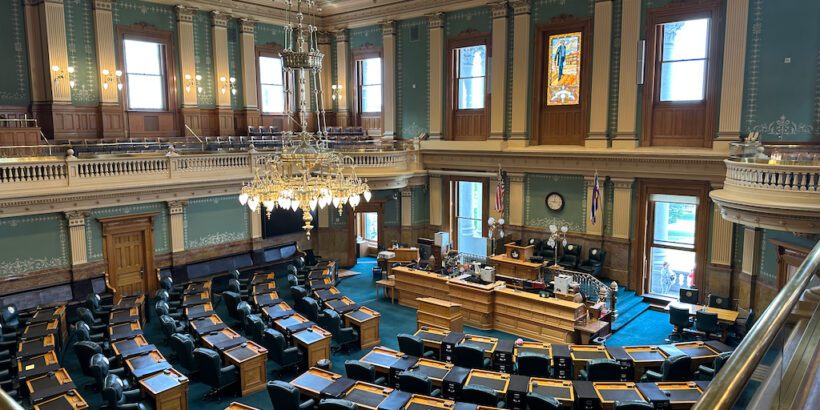
Colorado State Capitol Tour Review: Stunning Architecture & Historic Corridors
There’s just something about visiting state capitals that is so charming and interesting.
Within their hallowed halls, colossal government decisions take shape, impacting the lives of countless individuals annually. If only the walls could whisper their stories, they would regale us with captivating tales of power, progress, conflict, and change.
Yet, state capitals are not mere bureaucratic centers; they are treasure troves of history, where the past echoes through opulent architecture and resonates within artistic masterpieces. And in Denver, the Colorado State Capitol epitomizes this.
Below, I’ll give you everything you need to know about visiting the Colorado State Capitol. I’ll provide you with the inside scoop on the tours and some interesting information to help you best prepare for your visit! I’ll also share a lot of photos of the Capitol, giving you a virtual tour of sorts.
How to tour the Colorado State Capitol
The Colorado State Capitol is open Monday through Friday from 7:30 AM to 5 PM.
The tours of the Capitol building are offered Monday through Friday and are 100% free. Typically, the daily tours are offered four times a day: 10 AM, 11 AM, 1 PM, and 2 PM. Each tour is limited to a total of 15 people and is offered on a first-come, first-served basis.
Because the tour schedule is subject to change, it’s a good idea to contact the Capitol before visiting. You can do so by calling 303-866-2604.
If you’re coming in with a vehicle, recommended parking garages include: Denver Post Building Garage and Cultural Center Complex Garage. There is some street parking available around the perimeter of the park but it is limited in availability.
Personally, we like to park at the Cultural Center Complex Garage because it’s so easy to find a spot and they also have EV parking.
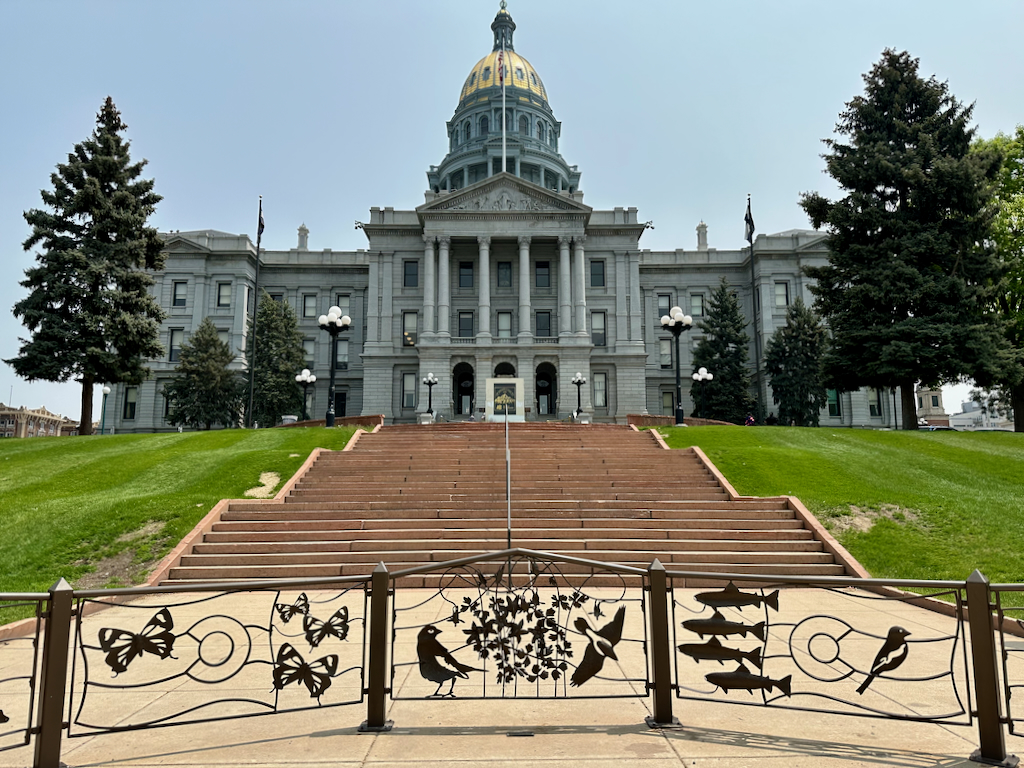
Our experience touring the Colorado State Capitol
We arrived around 10:30 AM to the capitol building after not having any luck with openings for the US Mint Tour .
We made our way through the security line and then went up to the front desk to schedule a tour. They told us that one would be available at 11 AM, took down our names, gave us our tour stickers, and then all we had to do was wait around a little bit.
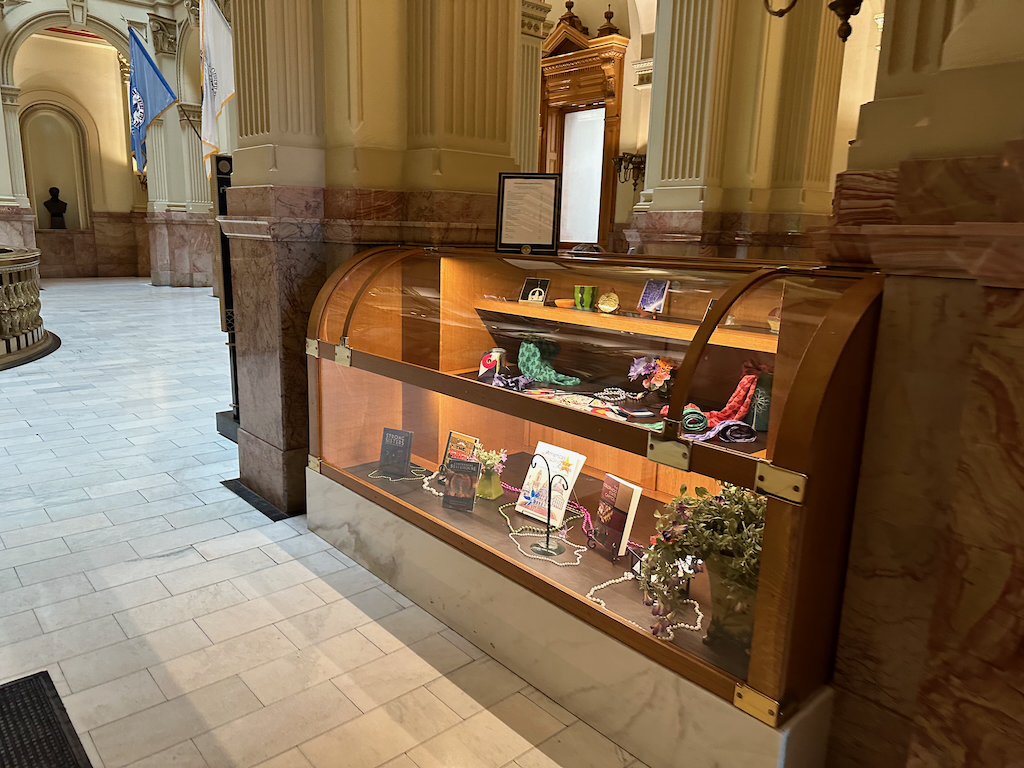
If you plan on doing the capital tour I would suggest you to do three things :
First, if it’s going to be a warm day, consider wearing lightweight clothes or layers that you can remove later, as it tends to get quite warm inside the Capitol building.
Second, have a bottle of water with you as you will probably work up some thirst. If you go downstairs there is a snack bar so you can grab a snack or perhaps some water before you start your tour.
Thirdly, be sure to pick up the Colorado State Capitol visitor guide, which is available right after passing through security. It contains a useful map at the back that will help you navigate this immense Capitol building.
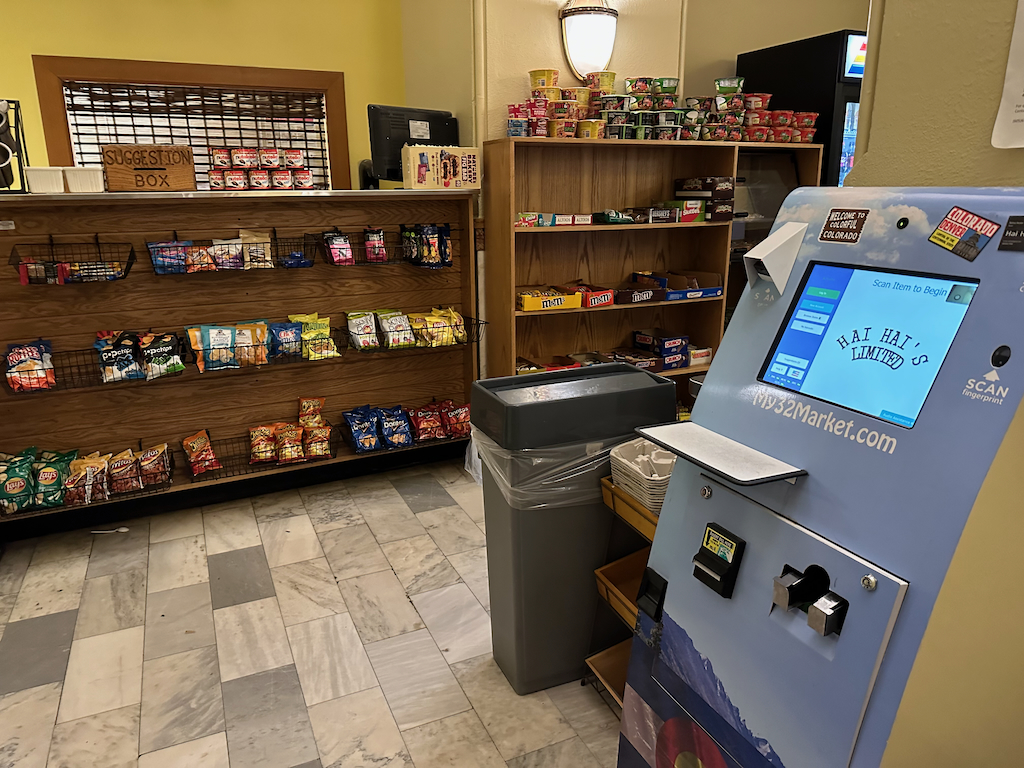
Right at 11AM, we met up by the flags near the information desk and our guide was right on time.
She was very friendly and knowledgeable and gave us a lot of insight into the history of the state of Colorado to kick off the tour.
We proceeded to the “Women’s Gold Tapestry,” a hand-stitched embroidery measuring 9 x 12 feet. It took 4,500 hours and two years to complete, and serves as a tribute to the bravery, resilience, and sacrifices of women in Colorado. You can delve into the tapestry’s story and explore the history it portrays with your guide, including the legacy of Mother Cabrini .
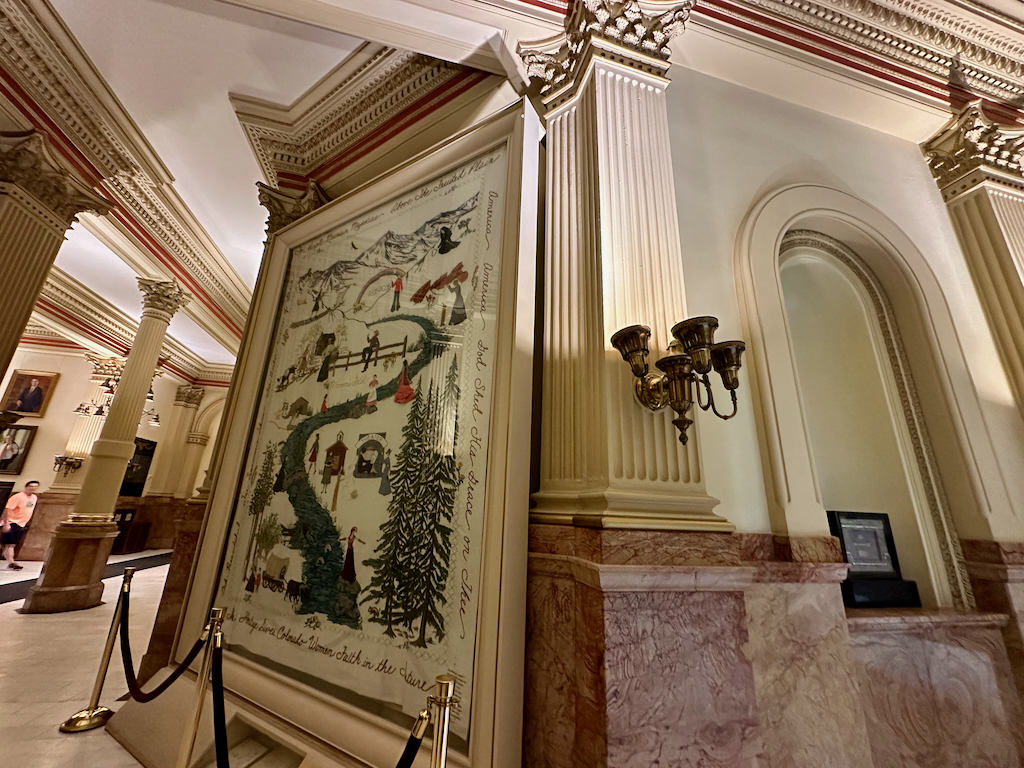
Our guide then told us about some of the fascinating details regarding the Capitol’s construction and design.
To my surprise, I learned that the architect responsible for this building, Elijah E. Myers, also designed the capitol buildings in Texas and Michigan. It took 15 years to finish the building which occurred in 1901 although some of the offices were in use before then.
The original building committee was determined to utilize local materials, and thus it comes as no surprise that the exterior of the capitol building, with walls up to 5 feet thick, is constructed from granite sourced from Gunnison, Colorado.
And the gold dome? It was adorned with thinner-than-tissue-paper gold leaf back in 1908, using gold sourced from a Colorado mine. In 2013, the gold was refreshed with 149 gold rolls, totaling 64.5 ounces of gold.
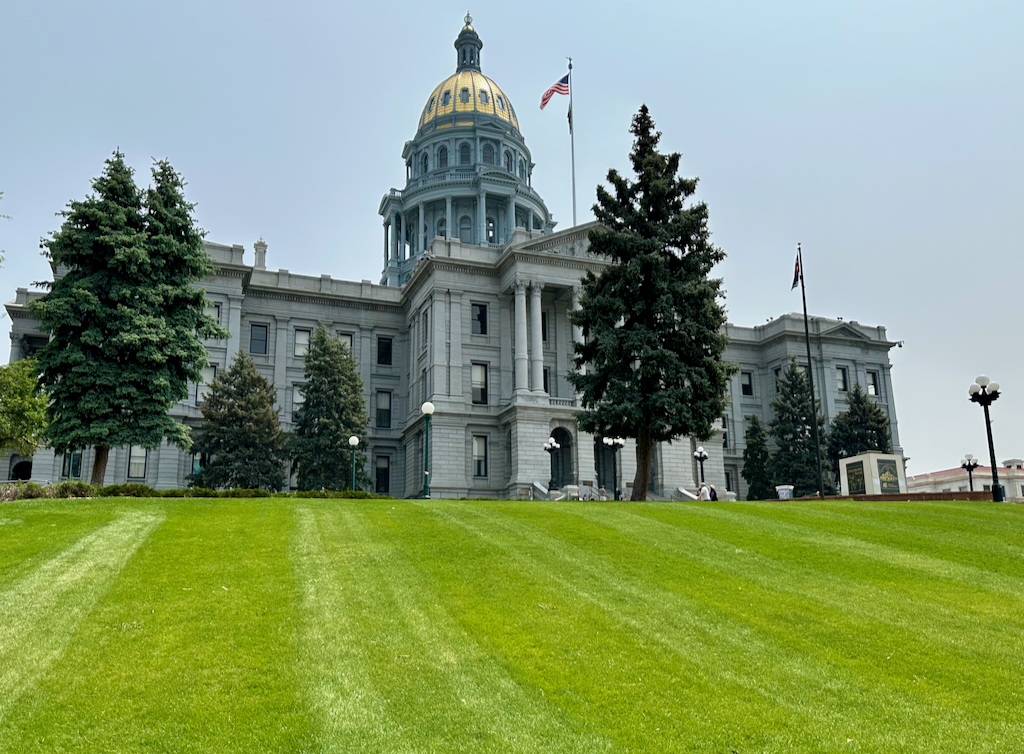
Another unique and noteworthy feature of the building is the onyx used in its construction. The exquisite pinkish stone, known as “rose onyx,” was found in Palua, Colorado (the stone is actually a form of oxidized limestone).
The installation of this rare onyx took seven years to complete, and it is said that this particular type of onyx cannot be found anywhere else in the world.
Within the intricate patterns of this onyx, observers over the years have discovered a captivating menagerie of shapes, ranging from the silhouette of a turkey to the iconic visage of Molly Brown herself!
Seeing this rare stone up close is a treat and allowing your imagination to unravel the secrets hidden within the walls is definitely a highlight of the experience.
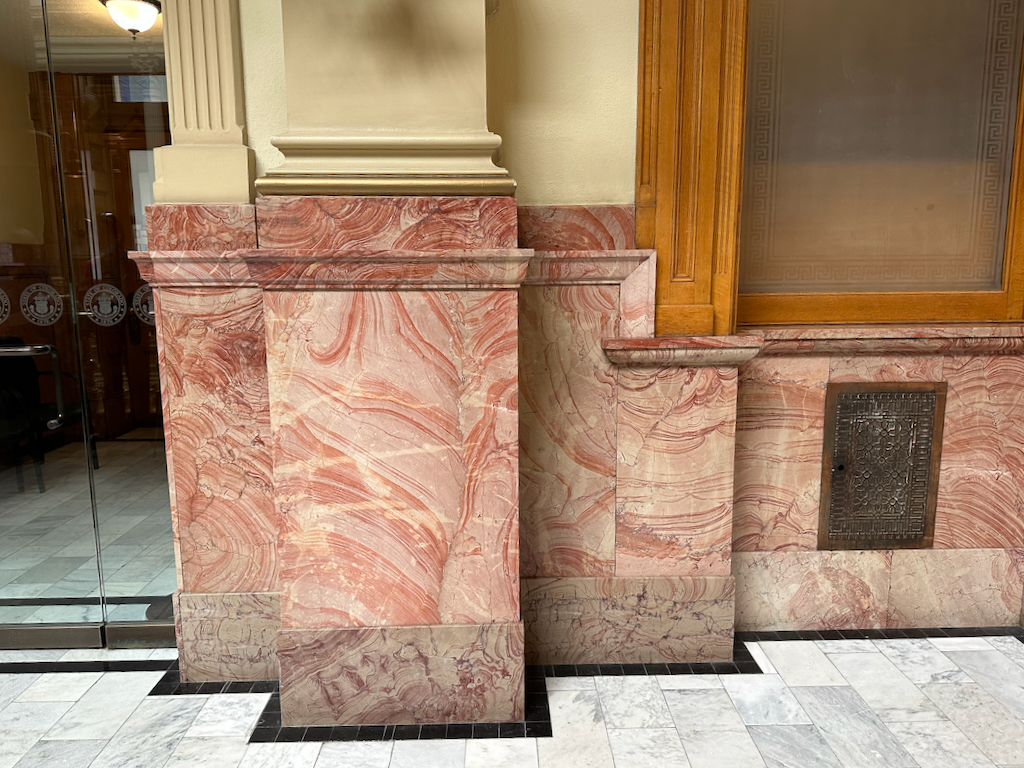
The floors also hold significance as they are made of Yule marble from Marble, Colorado. This is the same type of marble used in the Tomb of the Unknown Soldier and at the Lincoln Memorial in Washington, D.C , forging an interesting link between these esteemed structures and lending an air of shared history.
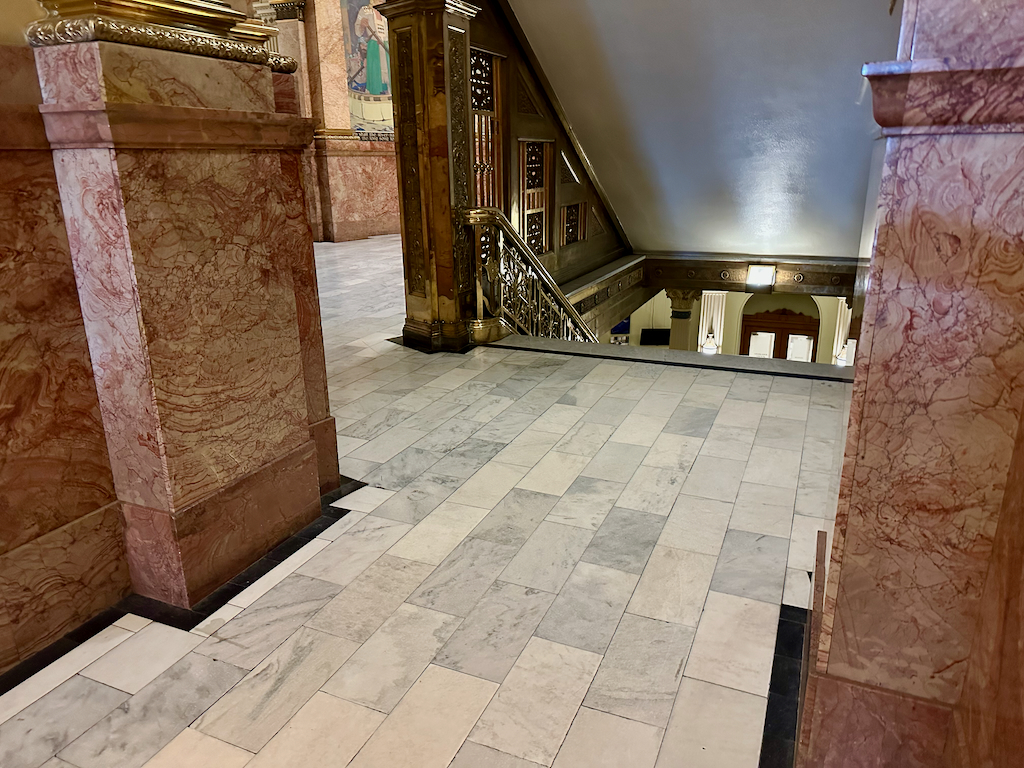
The only exceptions to Colorado-sourced materials are the brass and white oak found amid these stately quarters.
The intricately carved white oak, embellishing specific doorways, originates from the Ozark mountains in Arkansas and Missouri, while the brass used in the light fixtures and balusters was cast in Louisville and Cincinnati.
The light fixtures found in the Capitol building are intriguing because they were created during a period when builders harbored doubts about electrical lighting. As a result, they were constructed with the versatility to be powered by either gas or electricity.
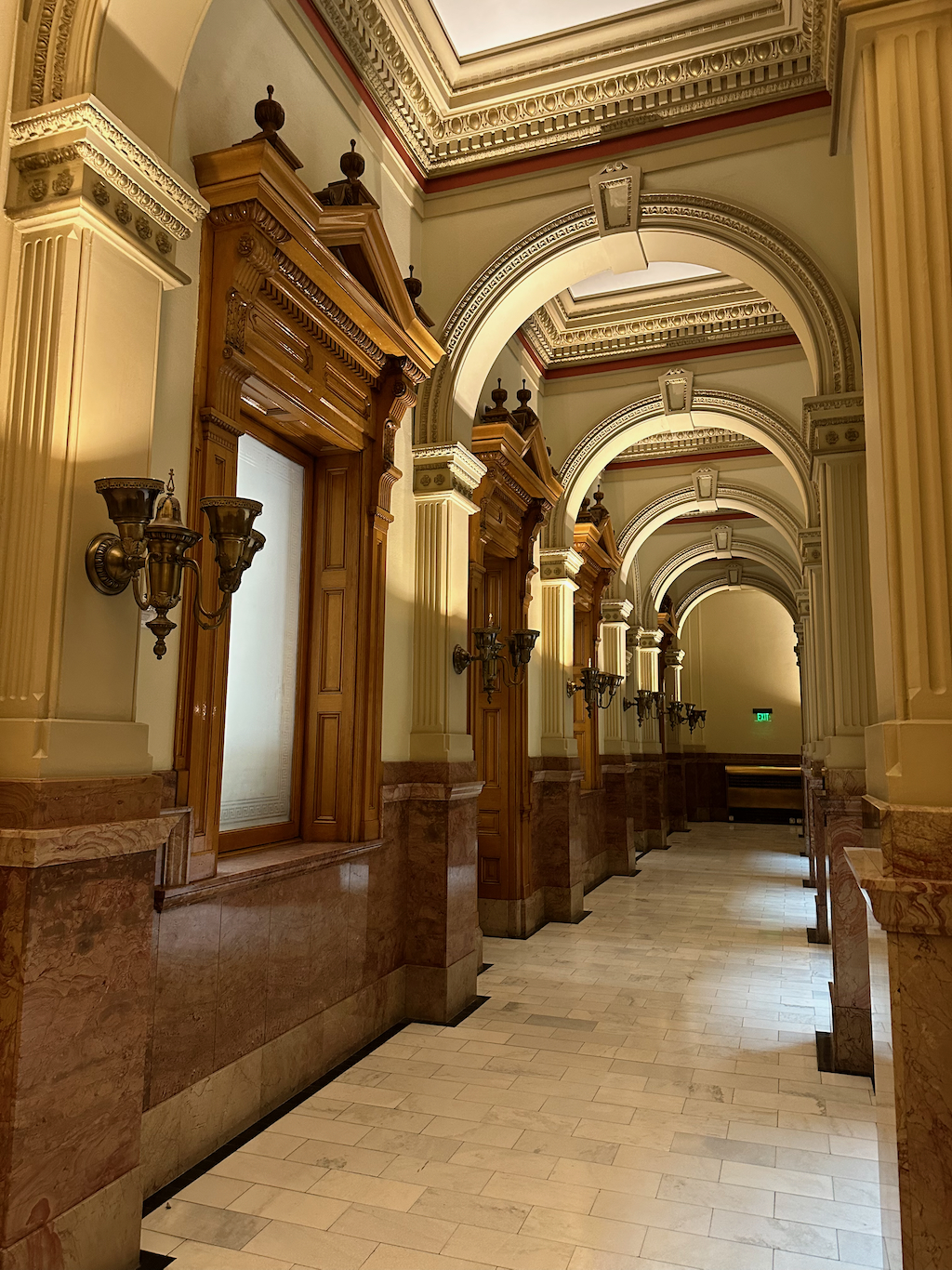
After getting the scoop on all of the building materials, we then made our way over to the grand staircase which is a beautiful staircase found in the heart of the rotunda on the first floor. It features 57 steps and 176 brass balusters and if you ask me, it’s quite a masterpiece.
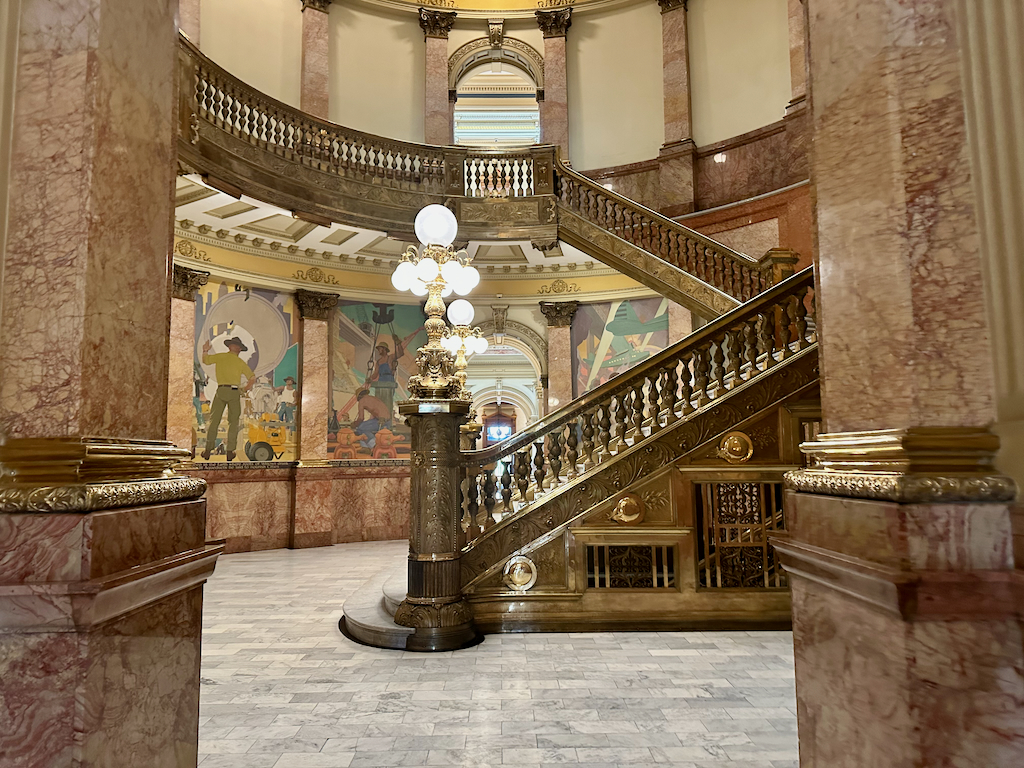
It’s adorned with oak leaves and acorns cast in brass. Don’t forget to cast your eyes skyward and behold the awe-inspiring sight of the rotunda ceiling which rises about 180 feet above you.
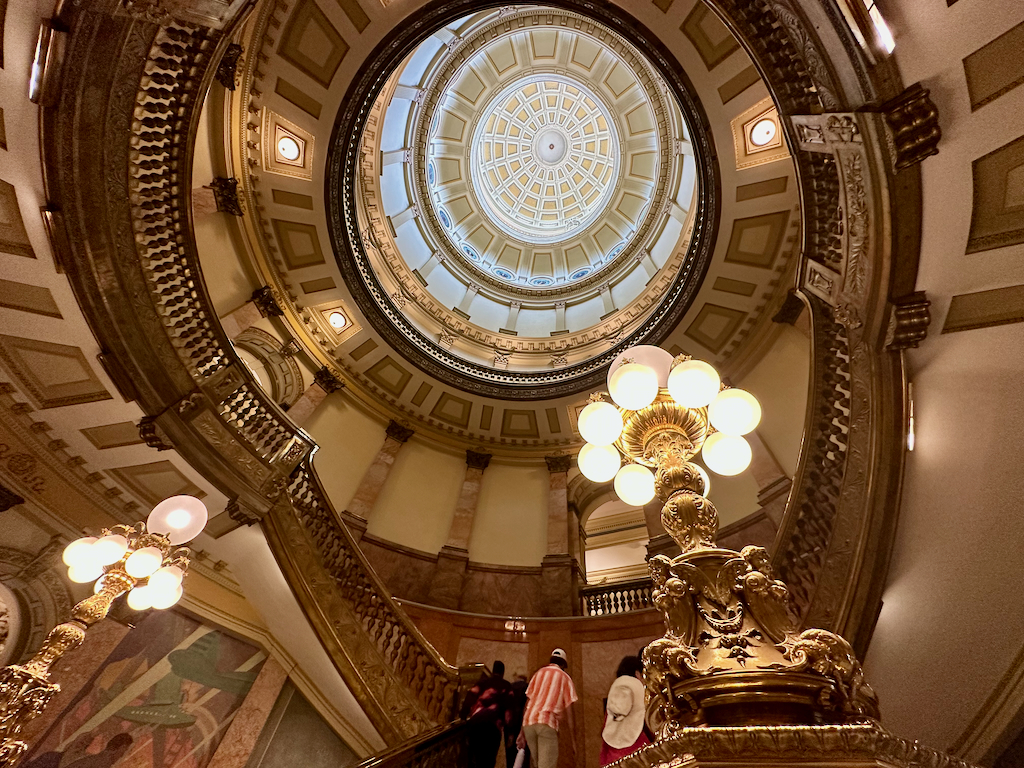
Surrounding the staircase are eight murals completed in 1940. They depict the story of Colorado’s water, accompanied by the poetic words of Thomas Farrell.
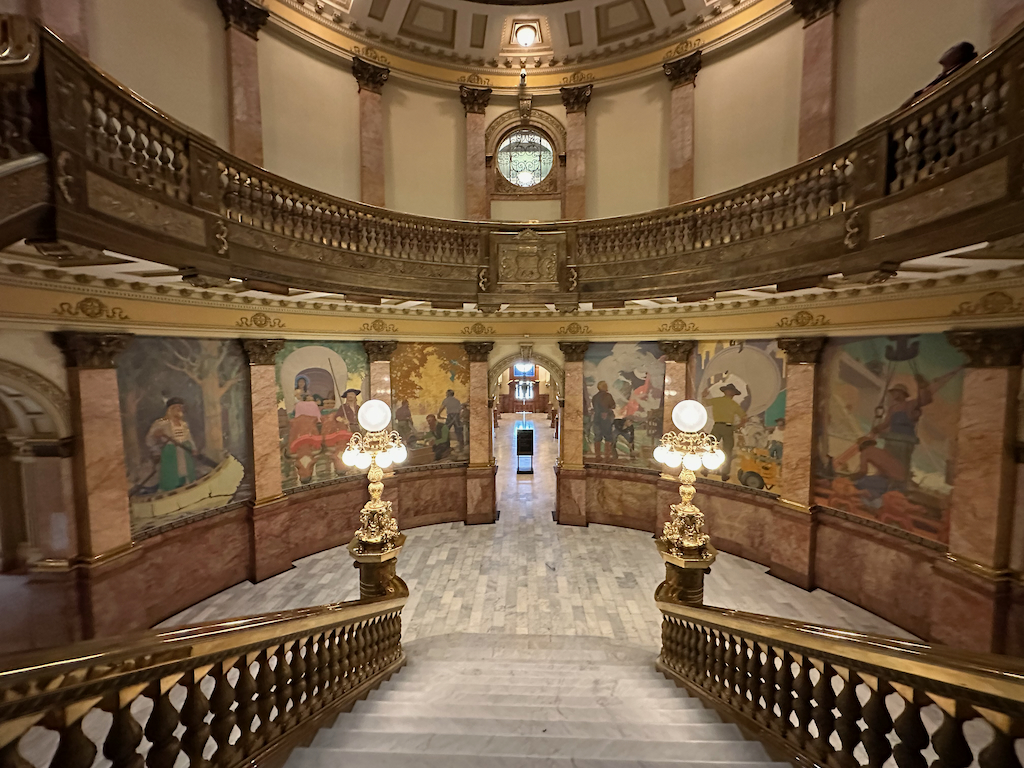
The artist behind these murals, Allen True, also painted some of the murals found in Civic Center Park .
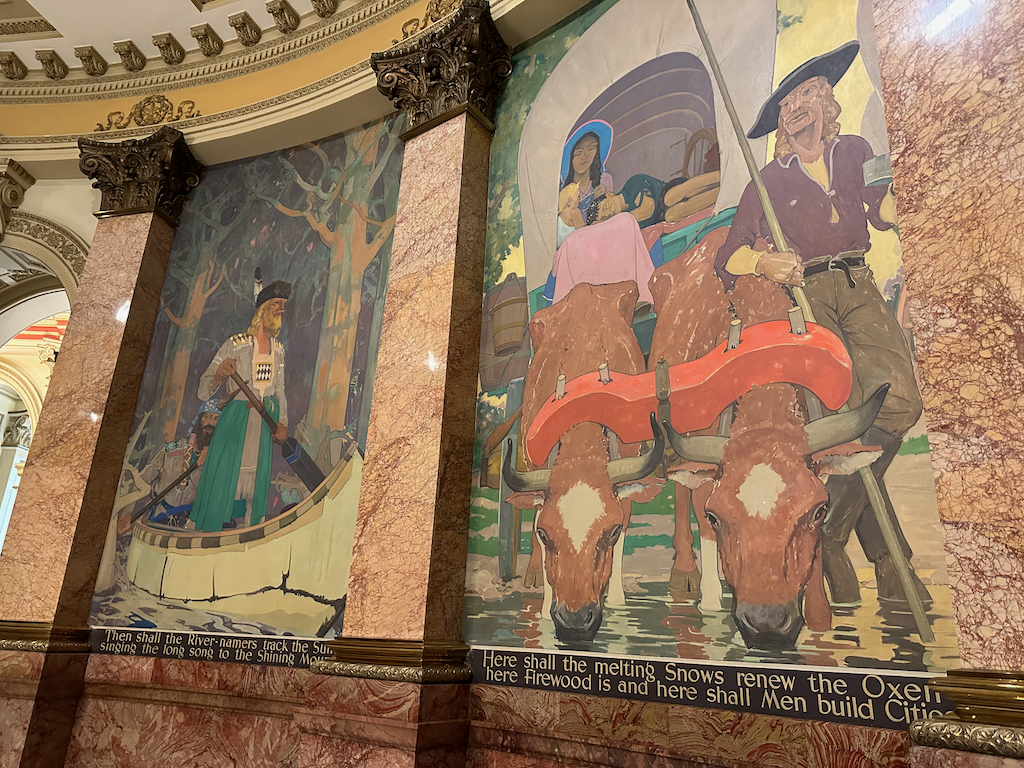
After examining the murals, we proceeded to the second level to catch a glimpse of the former Colorado Supreme Court, situated in the northern wing of the Capitol building. It is worth noting that the Supreme Court has since been relocated just across the street, so now this historic room is used for legislative meetings and hearings.
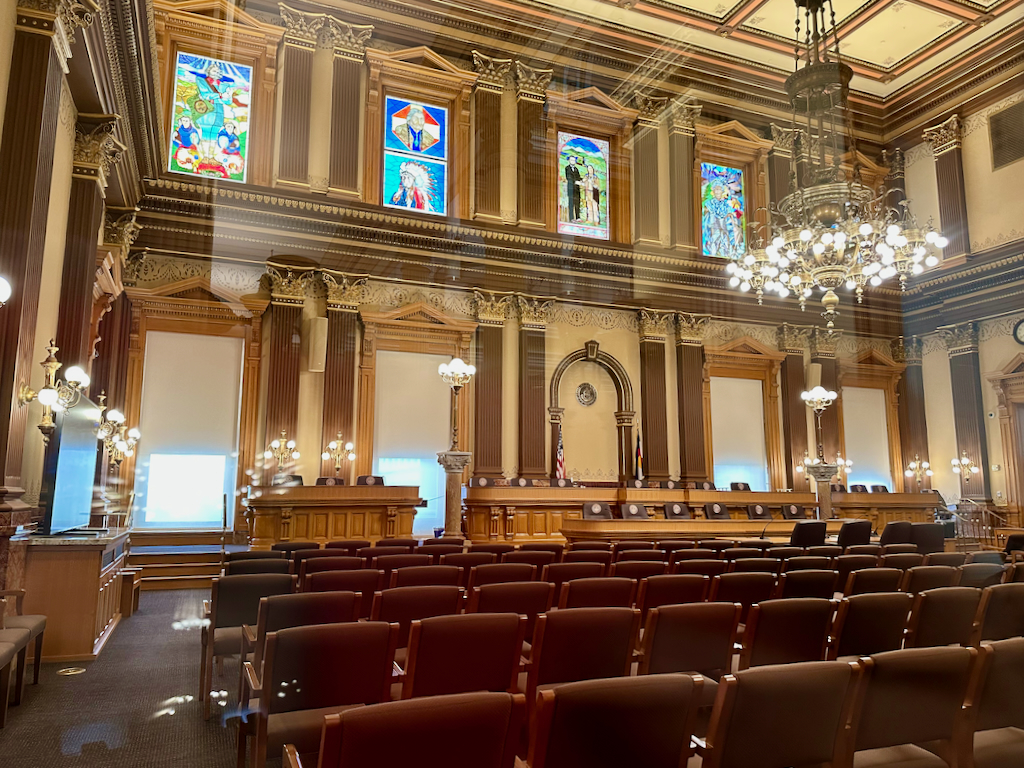
After that, we would take the stairs up to the third-floor although if you are not able to take the stairs or choose not to, there are accessible elevators.
We headed to view the impressive House of Representatives, where lawmakers convene to debate and shape the future of Colorado.
In Colorado, it comprises 65 members who serve two-year terms, with each member representing approximately 89,000 people. Be sure to take note of the rules before entering the room, including the requirement to remove your hat.
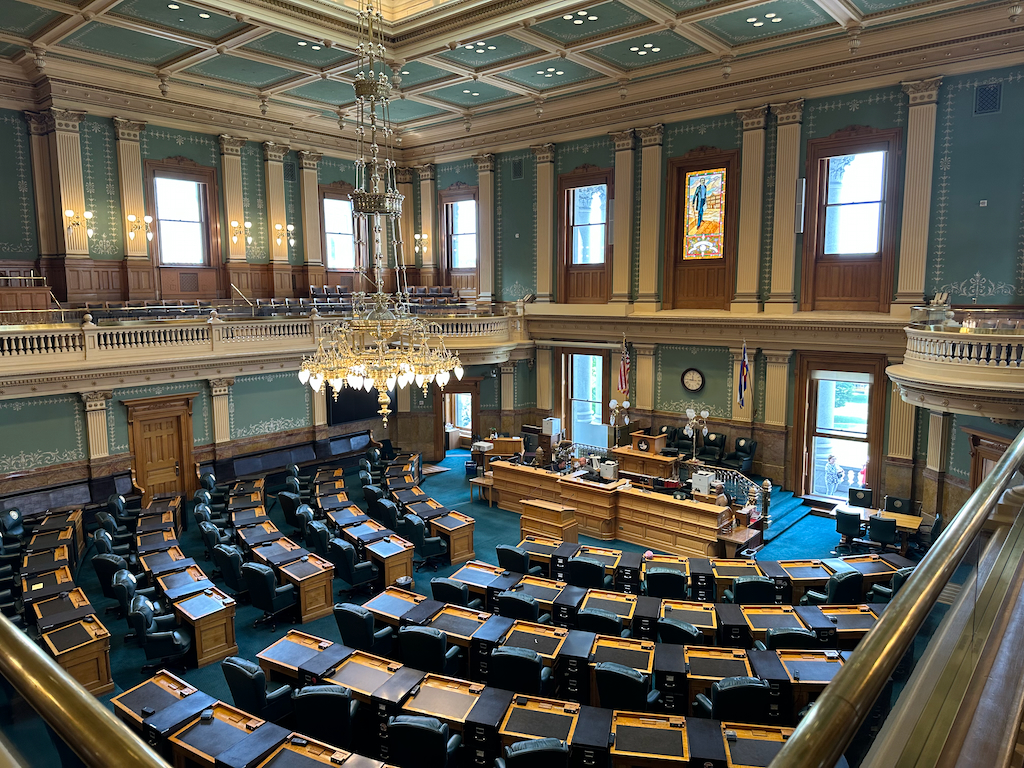
You can also go into the Senate chambers although on the tour for the sake of time they did not take us through there (we visited it later).
It’s another beautiful venue that is located on the same floor as the House. You’ll see 11 windows on the back wall of the Senate chamber but there are actually 12 windows as one is hidden right behind the Senate presidents dais.
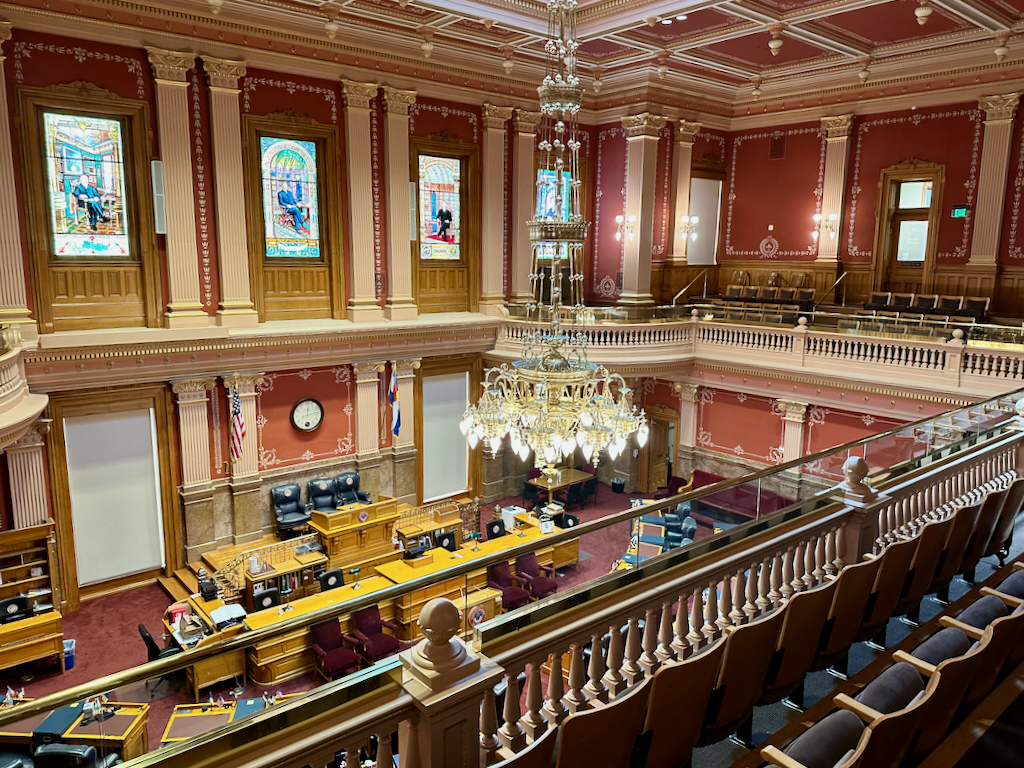
On that level, you can also explore the Senate hearing rooms and a press room where you have the opportunity to stand behind the podium and capture a stylish photo.
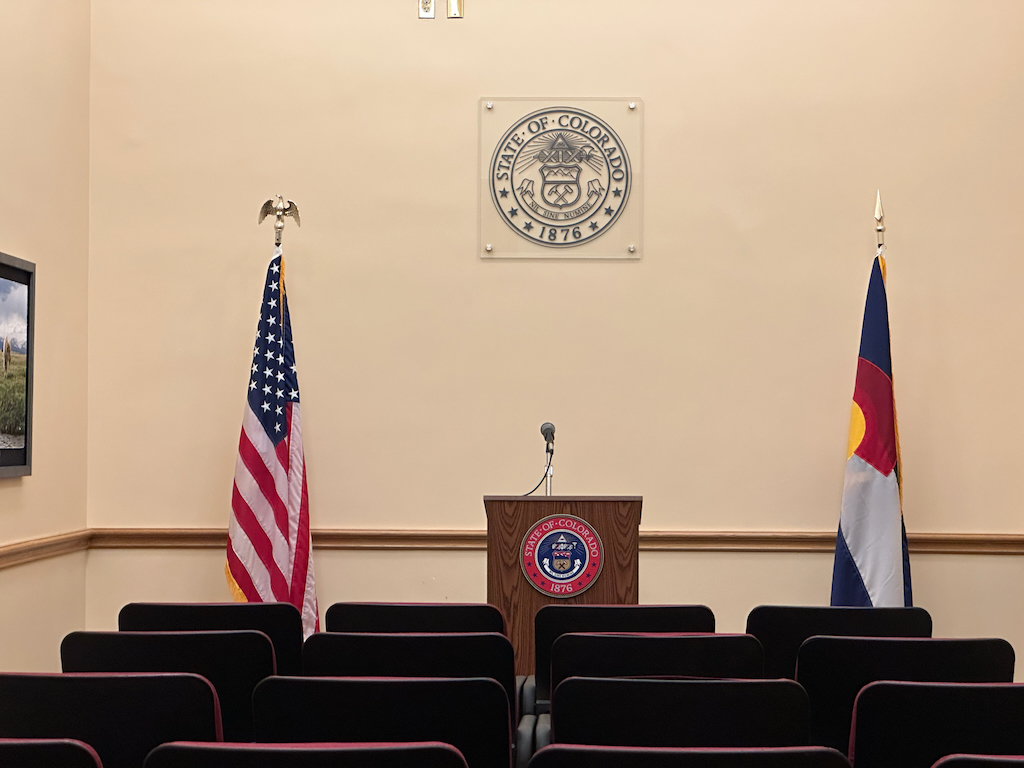
Next, we visited the rotunda where you’ll find portraits of all the presidents of the U.S. The portraits are displayed once the president’s term is completed, which is why we didn’t see Joe Biden in 2023. This was one of my favorite parts of the Capitol, as it’s a very beautiful area.
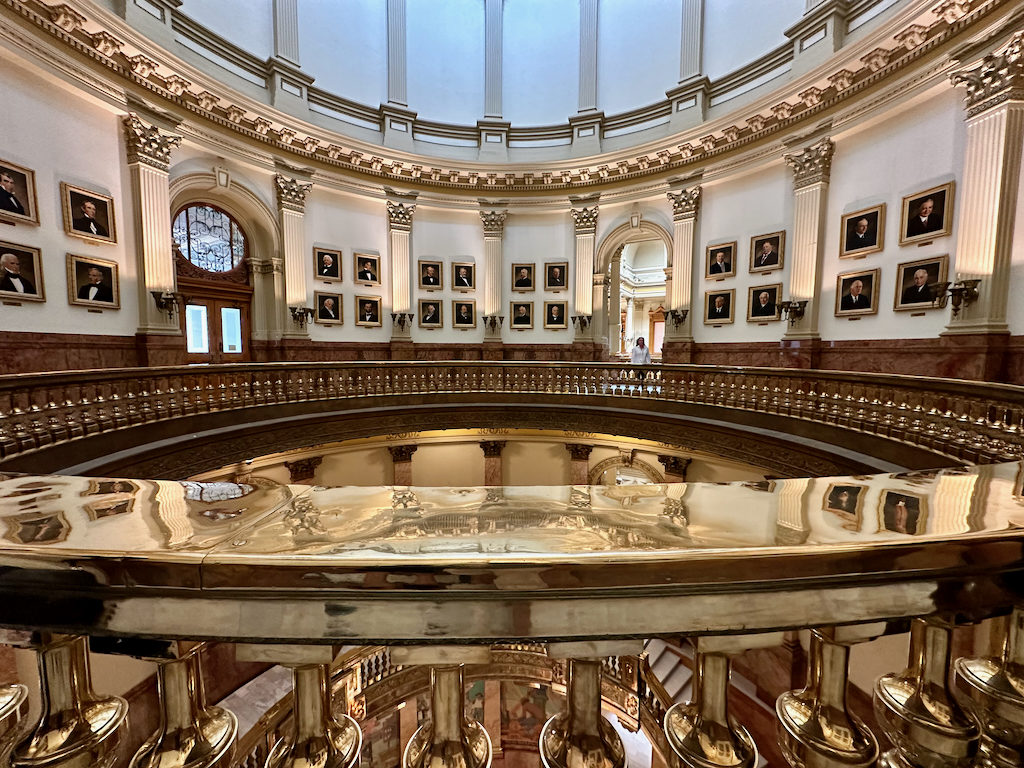
Then it was time for the tour to head up beyond level 3.
There are no elevators to head up there so if you have mobility issues and/or the idea of hitting up 99 stairs does not appeal to you, you may want to opt for a different option which is a video that plays and shows you what you would be seeing.
We opted to take the stairs up which honestly were not that bad.
First, you’ll go up a few sets of stair cases which takes you to a small museum.
The museum, which is called “Mr. Brown’s attic,” covers all things Colorado and has some interesting insight into the capitol. This area is open to the public (no tour needed) between 10 AM and 3 PM and you find it between level three and the dome.
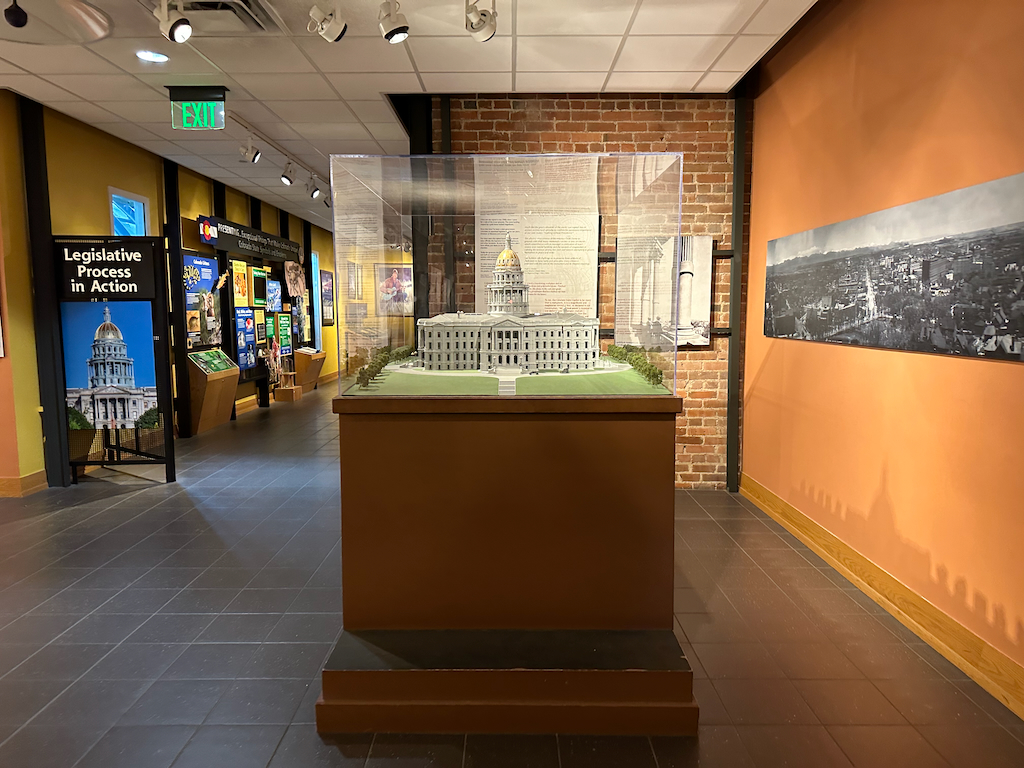
If you’re taking the guided tour, you can continue on for the dome walk. You’ll be handed off to some guides who will take the group up some fairly narrow stairs to the observation deck.
The stairs might seem a bit daunting, but before you realize it, you’ll be up at the observation area.
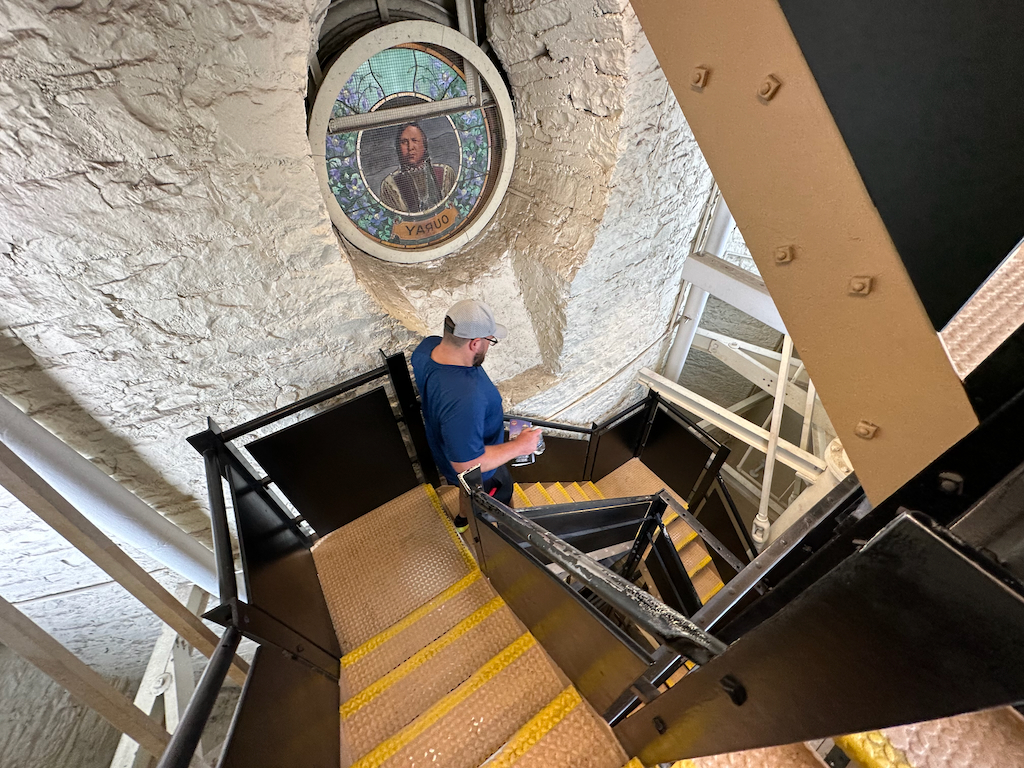
From the dome there are some great views of the Denver skyline, the City and County building across from Civic Center Park, and often the Front Range mountains. During our visit, a delightful breeze swept through, making the experience even more enjoyable and I’d even say romantic.
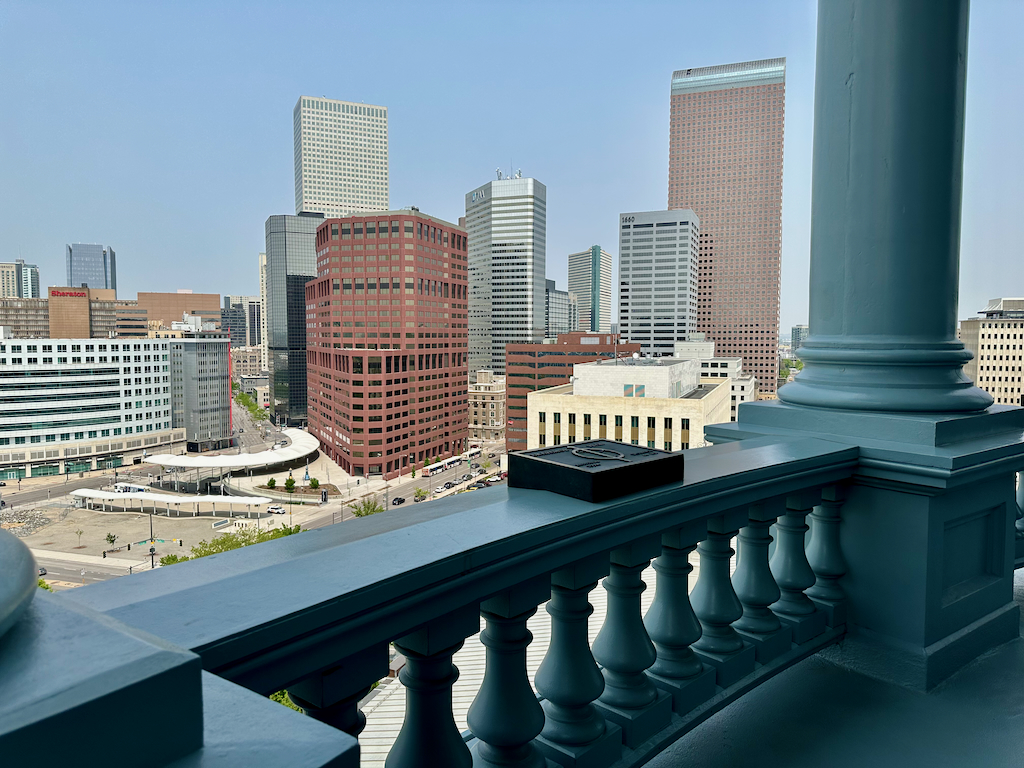
While the temperature was great, we visited on a day when the smoke was still clearing from fires but we could just barely make out some of the mountains.
Up there you’ll also find markers that indicate the direction of famous landmarks such as Pikes Peak.
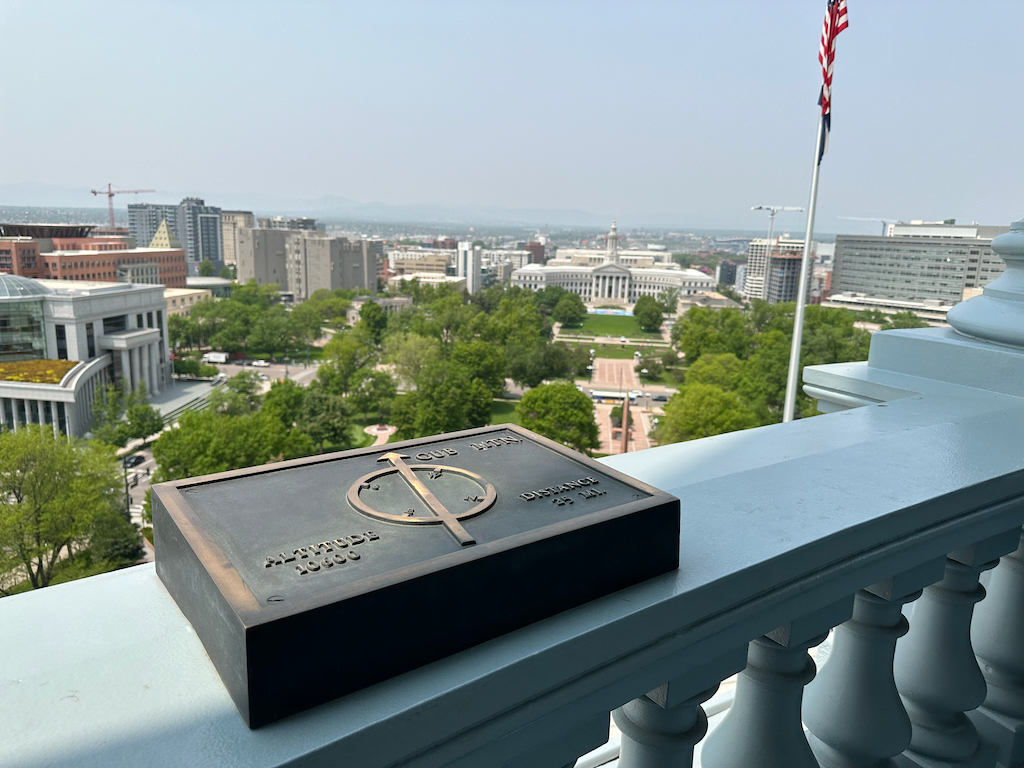
While you’re up there, take a moment to admire the stained glass windows below.
Installed in 1900, these 16 windows form the renowned Colorado Hall of Fame. There are little interpretive panels hanging on the railing that you can read to learn a little bit more about each of these individuals such as John Evans, the founder of the University of Denver.
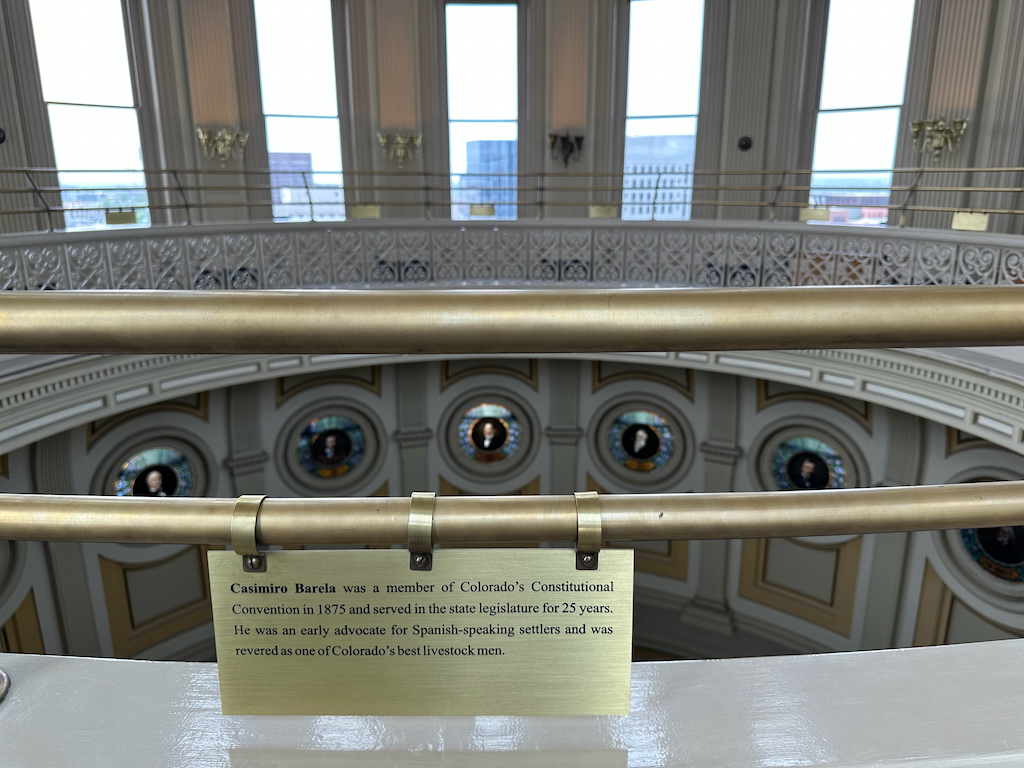
A gnarly spiral staircase heads up a few more stories but that staircase was off-limits to us.
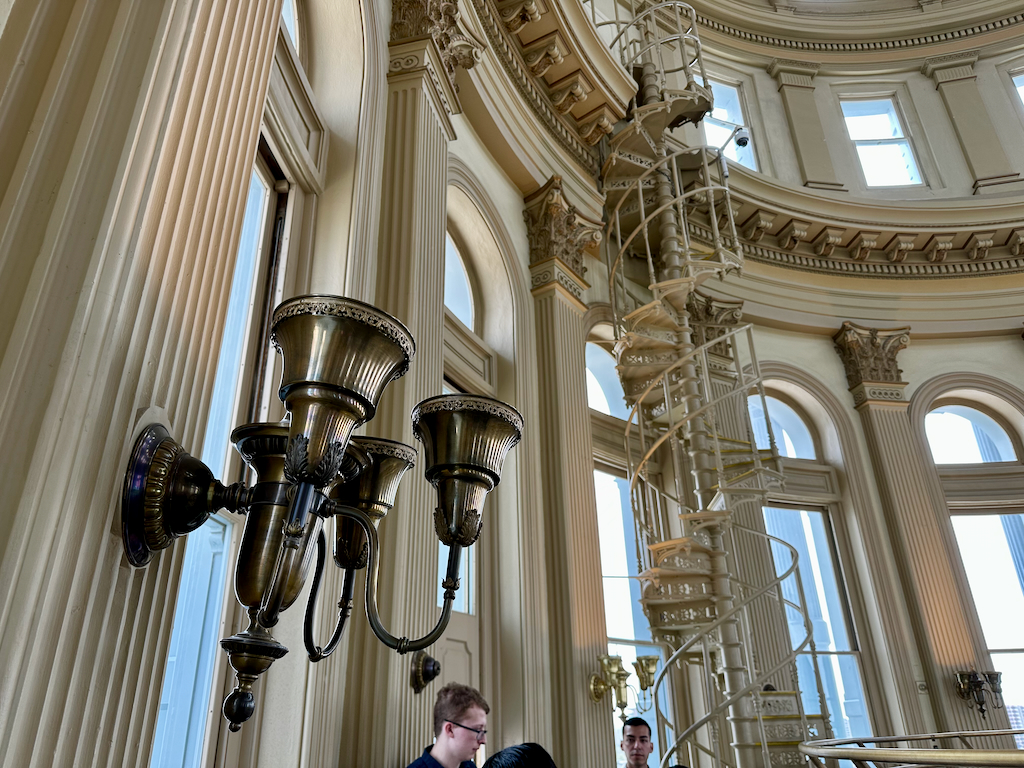
After the tour, we were able to head down from the observation deck and then explore the Capitol building ourselves.
Make sure that you head out to the front of the building to check out the famous “mile high” steps which have their own unique history.
There are multiple markers on the steps which illustrate how advances were made in surveying and engineering over the years as surveyors attempted to precisely determine the elevation of the steps.
If you’re looking for the official marker, it’s going to be on the 13 th step which was installed in 2003 and as far as we know, it’s the most accurate.
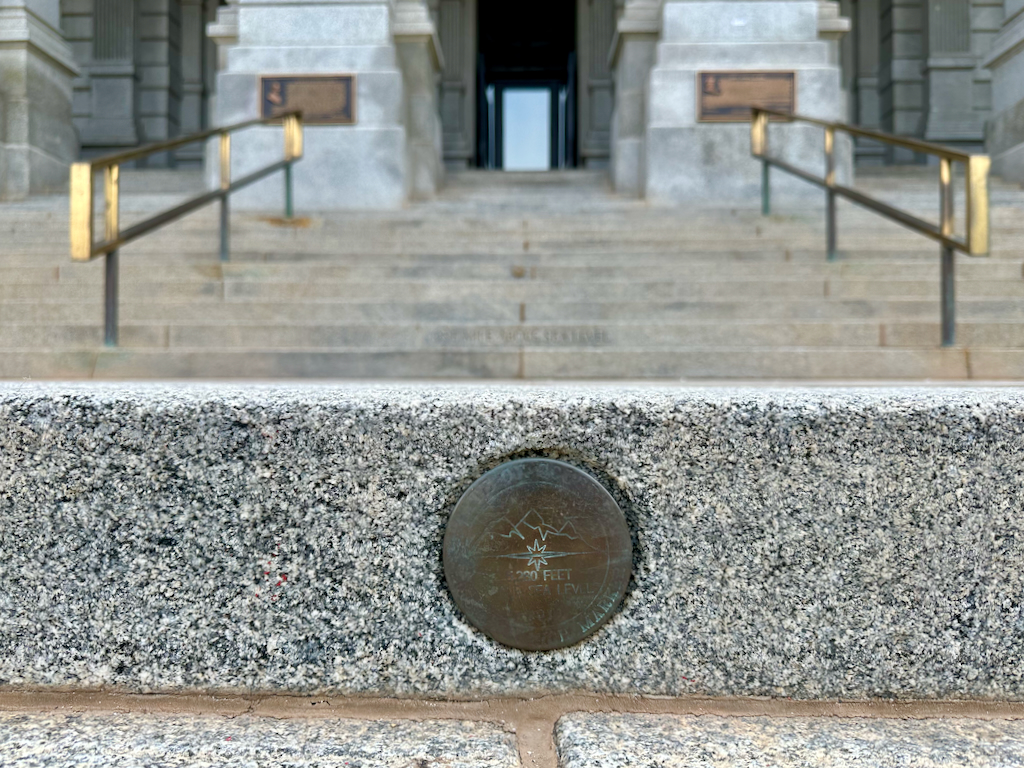
Overall, I enjoyed our tour and it did help to get some special insight into the formation of the state of Colorado and the Capitol building itself. If you’re the type of person who likes to follow along on tours, I think it’s worth it especially because it’s completely free.
Personally, I’d like to do my own exploring and with the visitors guide and a little bit of pre-visit research, I think you could probably appreciate everything on your own without missing out on too much if you choose to not do the tour.
However, the one big thing you will miss out on is being able to climb up into the dome and appreciate the views and architecture up there which is definitely a major highlight of the tour.

Daniel Gillaspia is the Founder of UponArriving.com and the credit card app, WalletFlo . He is a former attorney turned travel expert covering destinations along with TSA, airline, and hotel policies. Since 2014, his content has been featured in publications such as National Geographic, Smithsonian Magazine, and CNBC. Read my bio .
Leave a Reply Cancel reply
Your email address will not be published. Required fields are marked *
Privacy Overview
- Skip to right header navigation
- Skip to main content
- Skip to primary sidebar
- Skip to footer

- Trip Planner
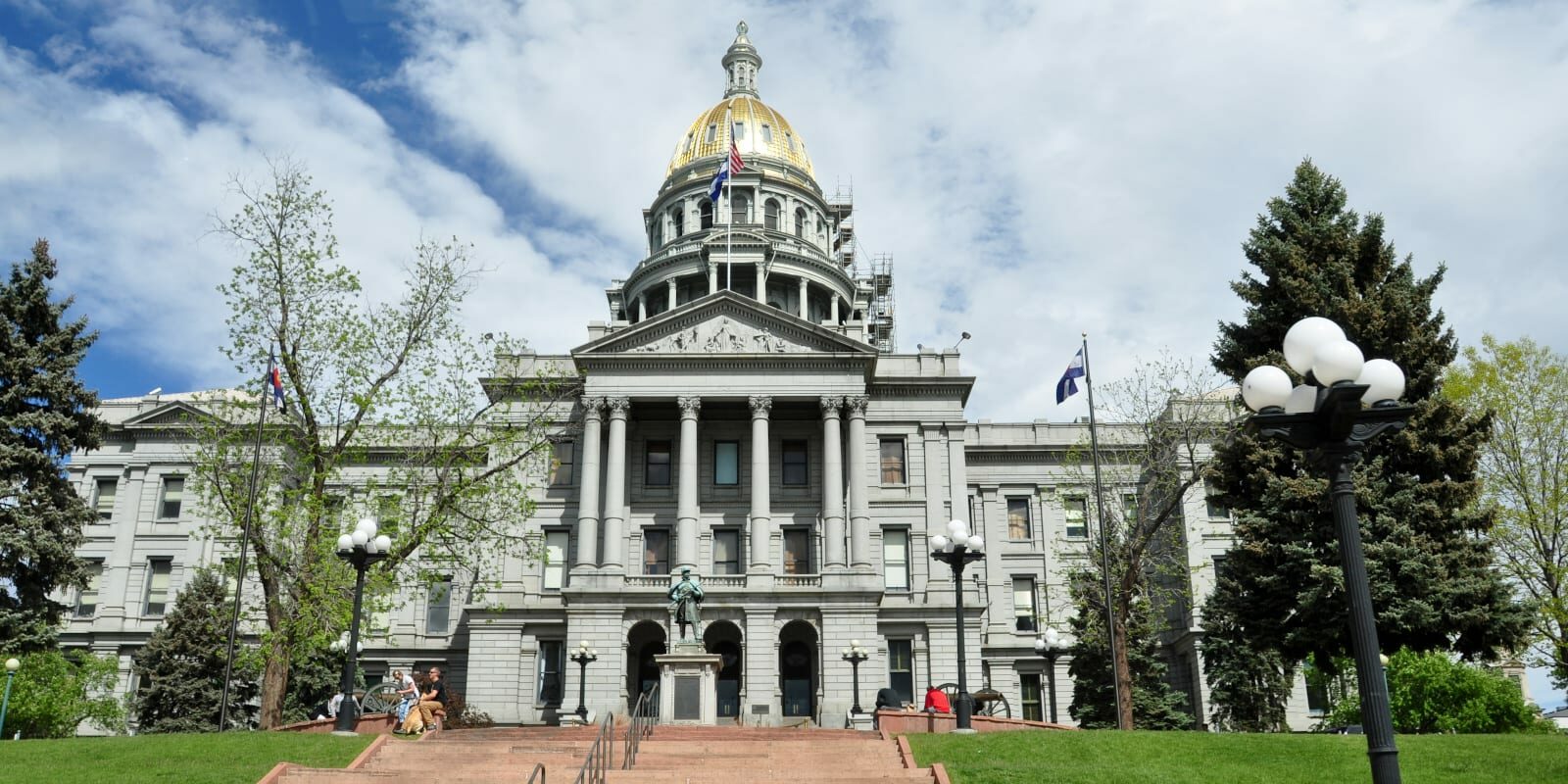
Colorado State Capitol Building – Denver
Denver’s skyline wouldn’t be complete without Colorado’s golden-domed State Capitol building. Constructed over the course of 5 years, the Capitol building was completed in 1901 and serves as the home of Colorado’s most influential branches of government: the Senate, the House, the Governor, the Lieutenant Governor, and the Department of the Treasury.
Though the building resembles the basic design of the Capitol building in Washington, DC, there are numerous architectural elements that are incredibly unique and native to Colorado. Notable local Colorado building materials include:
- The rare rose onyx was found in Beulah, CO , a magnificent pink stone applied as wainscoting and column plinths.
- The marble floors originate from the namesake town of Marble, CO .
- The granite for the Capitol’s exterior walls was sourced from Gunnison, CO .
- Even the golden dome has Coloradan roots, as local gold miners gifted 200 ounces of gold to gild the Capitol building’s most visible feature.
Touring the State Capitol Building in Denver
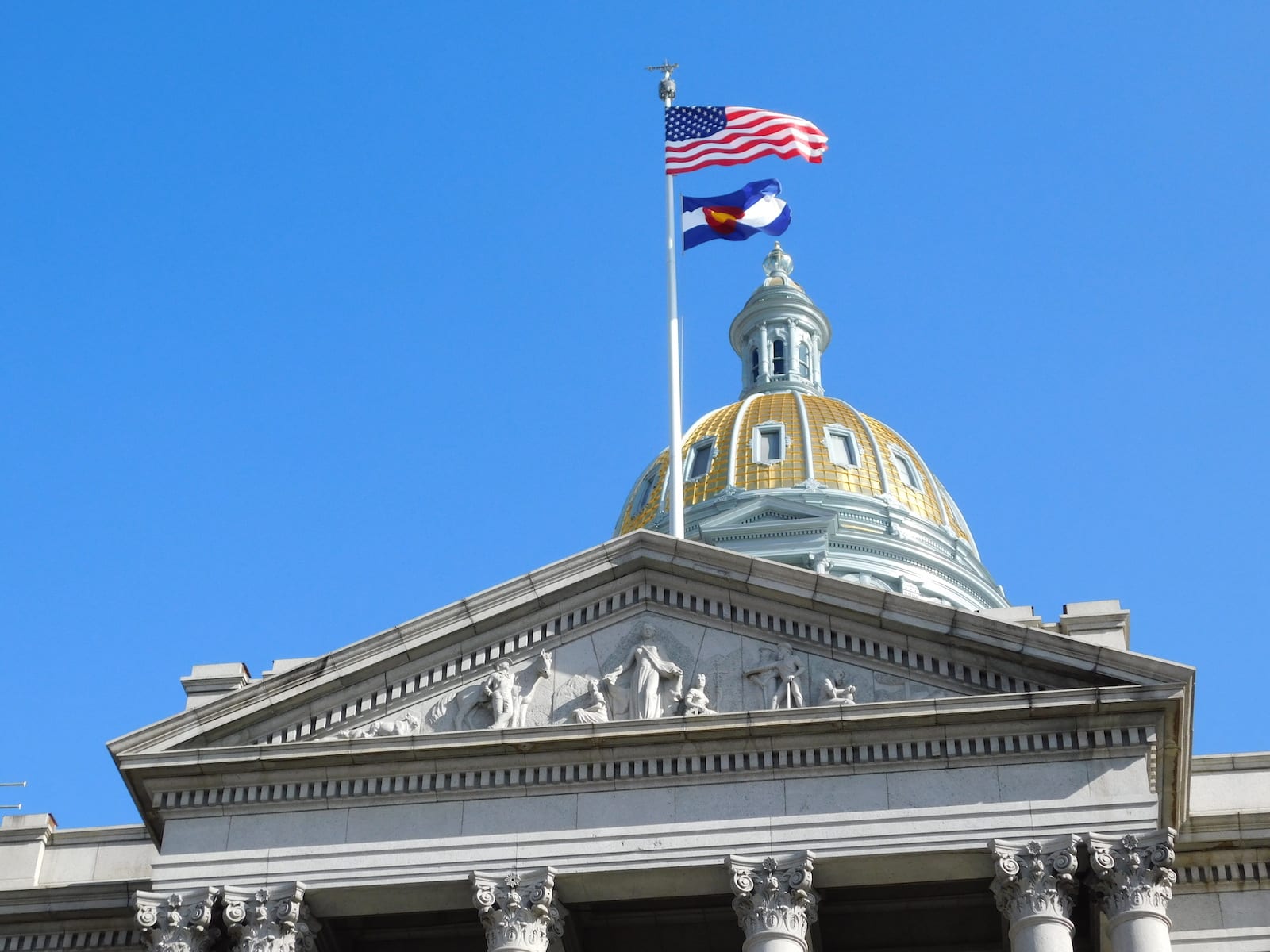
A visit to Denver isn’t complete without a stop at this magnificent structure. The Denver Capitol building oozes Coloradan pride, and there is much to learn by walking its grounds. The interior is stunningly designed, dripping in opulent combinations of brass, marble, oak, murals, stained glass, and unforgettably: rose onyx. The stained glass throughout the buildings was carefully thought out, depicting prominent events and people that shaped Colorado’s history.
But there’s more outside, too. On the West steps of the building, the 15th step is engraved, reading “One Mile Above Sea Level.” But over the years, this has been re-evaluated by researchers. Today, the 13th step is considered to be one mile above sea level, and it has also been marked. But, the 15th step shouldn’t be missed. From this step, you can revel in the view of watching the sun as it sets behind the Rocky Mountains.
Denver’s Capitol building is a must-see for lovers of architecture, history buffs, and first-time visitors of Colorado. Guided tours of the building are free and offered Monday through Friday, with the exception of holidays. It’s wise to arrive early to a tour, about twenty minutes in advance should suffice. They fill up quickly as they are limited to 30 people per tour.
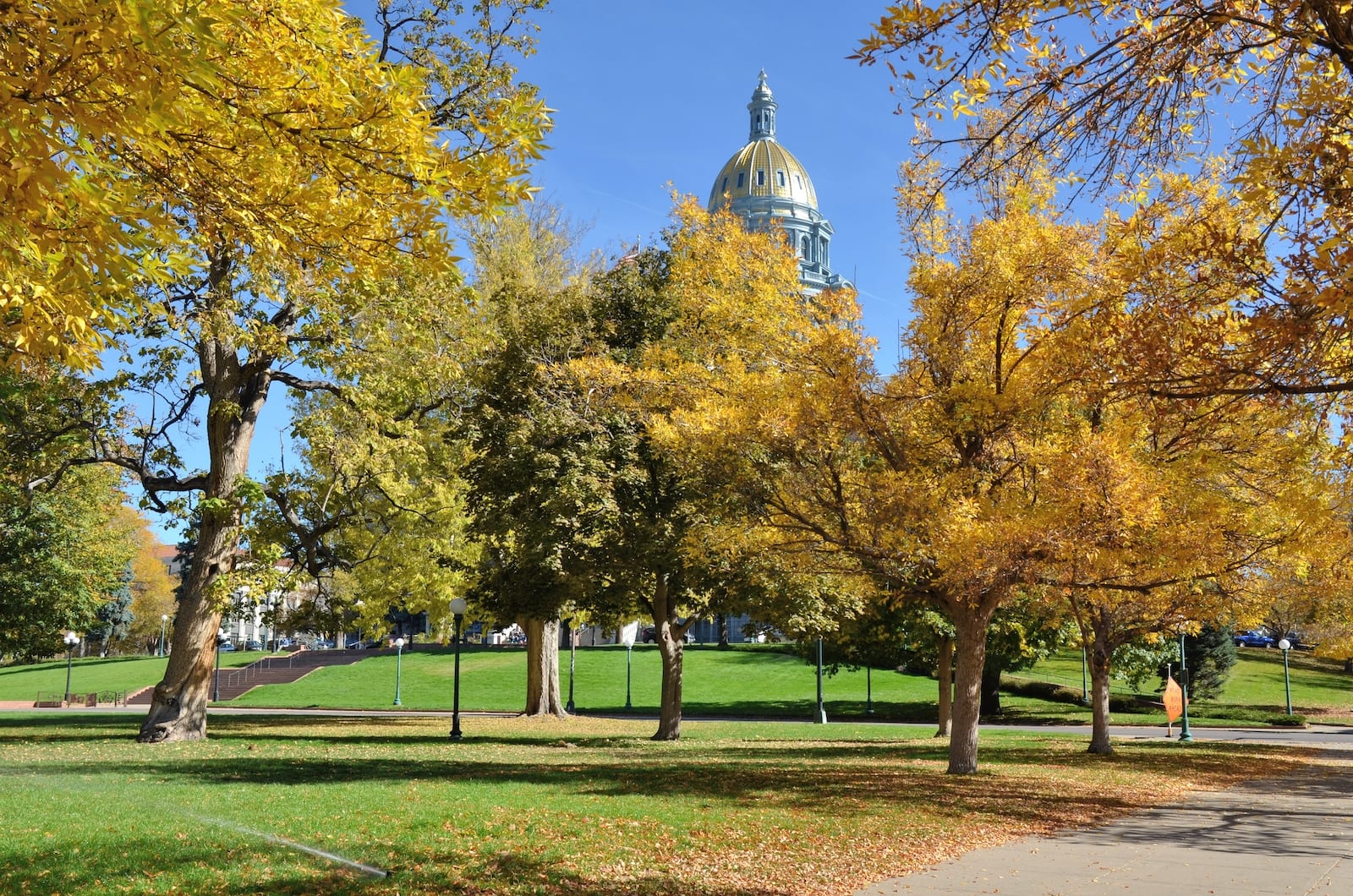
Address: 200 E Colfax Ave, Denver , CO 80203
Season: Year round, Monday-Friday, except holidays (public tours)
Admission: Free
Website: colorado.gov/pacific/capitol
Get In Touch
- Privacy Policy
- Disclaimer—Terms of Service
Things To Do
- Travel Blog
- Colorado Activities
- Colorado Events
- Colorado Towns
- Colorado Hotels
- Colorado Restaurants
- Colorado Transportation
- Made in Colorado
Fall Activities
- Federal Lands
- Ghost Towns
- Hot Springs
- Ski Resorts
- State Parks
- Train Rides
Tour of Colorado State Capitol
This event already ended.

- When: Tue, Mar 12, 2024 from 01:00 PM to 02:00 PM
- Committee: Rocky Mountain Over the Hill Gang
- Group: Denver
- Add to Calendar: iCal
A guided tour of the Colorado State Capitol building, which houses the offices of the governor, lieutenant governor and state legislators as well as both houses of the Colorado General Assembly. The Legislature is in session from January through May each year, so we may have the opportunity to see floor debate or a legislative committee meeting.
An optional happy hour will follow at the Art Hotel, 1201 Broadway, Denver.
Parking is limited at both venues, particularly with the Legislature in session, but there is a parking garage at the Cultural Center Complex, 65 W. 12th Avenue, Denver. The parking garage is next to the Art Hotel and about .4 mile from the State Capitol or a 10 minute walk.
With a friendly community, knowledgeable instructors and trip leaders, and a century-long legacy of adventure and education, the Colorado Mountain Club is the perfect way to explore Colorado
- Privacy Policy
- Terms & Conditions
- Bookseller Info
- Colorado Mountain Club

Connect with the CMC Community
© Colorado Mountain Club, a 501(c)(3) nonprofit organization. Tax ID: 84-0410760.
CMC Store is a registered trademark of The Colorado Mountain Club©, a 501(c)(3) nonprofit organization. Tax ID: 84-0410760.
DeGette Announces Winner of 2024 Congressional Art Competition

DENVER — Today, Congresswoman Diana DeGette (CO-01) announced Madison Lee from Denver School of the Arts as the winner of the 2024 Congressional Art Competition. The winning piece, titled “Bridging Identities,” was selected out of all the submissions by a panel of judges.
“The Congressional Art Competition showcases the incredible artistic ability of students throughout Denver, and this year’s submissions demonstrated an inspiring display of talent by our student artists,” said DeGette. “It was a competitive year with many great submissions, and I am proud to recognize Madison as this year’s winner. Her piece represents an important perspective of merging identities, something that underscores the culture of Colorado and the American West. I look forward to seeing Madison’s winning piece on display in the United States Capitol for the next year.”
Madison’s artwork will be hung in the United States Capitol alongside winners from other Congressional Districts across the country. Madison will be flown to Washington, D.C. to attend a reception for Congressional Art Competition winners.
This year’s submissions were judged by a panel of Denver-based artists, including Sofie Birkin, a Denver-based illustrator, Hadia Shaikh from Denver Art Museum , and Joann Asakawa from Meow Wolf Denver .
Each spring, the Congressional Institute sponsors a nationwide high school visual art competition to recognize and encourage artistic talent in the nation and in each congressional district. Since the Artistic Discovery competition began in 1982, more than 650,000 high school students have participated.
Students submit entries to their representative’s office, and panels of district artists select the winning entries. Winners are recognized both in their district and at an annual awards ceremony in Washington, DC. The winning works are displayed for one year at the U.S. Capitol.
Election Updates: Praising police, Trump calls crackdown at Columbia a ‘beautiful thing to watch.’
- Share full article

Chris Cameron
Donald Trump again attacked Robert F. Kennedy Jr., the independent presidential candidate who polls suggest is taking some support from Trump voters , in a post on his social media site, pleading that Republicans “don’t waste your precious vote on this phony liberal activist” while also insisting that Kennedy’s candidacy hurts President Biden more than it hurts him.
In an interview with local television in Waukesha, Wis., Donald Trump again said he would not sign a national abortion ban if elected , after a wide-ranging interview with Time magazine in which he suggested he would consider other federal abortion limits. He has struggled to strike a balance between siding with the anti-abortion activists who helped elect him in 2016 and what he sees as a risk to his electability.

Anjali Huynh
Trump has finished speaking in Freeland, Mich., where he blasted his New York criminal trial, laying into the judge who fined him, falsely suggesting the case amounts to political persecution and claiming, without evidence, that the trial is helping his poll numbers. The comments, among the first he’s made on the trail since the trial started, show how he plans to use the trial to rally supporters whenever he can hit the road.
In Michigan, Donald J. Trump again insists abortion should be left “to the states,” rather than supporting a federal ban. He praised the justices who overturned Roe but alluded to the electoral risk to Republicans, saying, “A lot of bad things will happen beyond the abortion issue, if you don’t win elections.” Kamala Harris, in Florida today, tried to make Trump the face of the state’s six-week abortion ban.

Michael Gold
At his second rally of the day, Donald J. Trump has spoken far more extensively about his criminal trial in New York, though he is mostly expounding on his view that the trial is, as he put it, “an unlawful exercise in very stupid and very evil politics” that is keeping him from campaigning.
Former President Donald J. Trump has taken the stage in Freeland, Mich., a state he visited last month for an event focused on illegal immigration and border policy. He opened today by briefly praising Mike Rogers, the Republican he endorsed in Michigan’s Senate race, before pivoting to criticizing the economy under President Biden.
Migrant crossings on the U.S.-Mexico border have dropped significantly in the first three months of the year, according to official figures , from a peak of 301,981 in December to under 200,000 a month from January to March. That could ease political pressure on President Biden, but Republicans are likely to continue attacking him by pointing out that border crossings remain relatively high.
Donald J. Trump, at a rally in Waukesha, Wis., called for tougher action against campus protests and again suggested some of the protesters were paid actors. He called on college presidents to “remove the encampments immediately, vanquish the locals and take back our campuses for all of the normal students.”
At his rally in Wisconsin, former President Donald J. Trump is again trying to walk a fine line on abortion. He is celebrating that the issue was returned to states after Supreme Court justices he appointed overturned Roe, while also criticizing Democrats for being too liberal and anti-abortion activists who are pushing for broader bans.
Former President Donald J. Trump, who has campaigned on a tough law-and-order message while facing criminal charges and criticizing the legal system, commended the New York police for arresting dozens of pro-Palestinian demonstrators at Columbia University. “That’s one good thing that really happened,” he said, adding later, “It was a beautiful thing to watch.”

Nicholas Nehamas
On the day that a six-week abortion ban went into effect in Florida, Vice President Kamala Harris warned a crowd in Jacksonville that Donald J. Trump would bring “more bans, more suffering, less freedom,” if he won in November. Harris and Democrats have sought to tie abortion bans directly to Trump, seeing abortion as a winning political issue.
Donald J. Trump at a rally in Waukesha, Wis., again contended without evidence that the protests at college campuses over the war in Gaza were an effort by the left to distract attention from the surge of migrants at the border. “Some people are saying they do the colleges so they can get your eyes off the border,” he said, repeating an assertion that he made on social media last night.
Donald J. Trump just took the stage in Waukesha, Wis., for his first rally since his trial in New York began. He noted that Republicans would hold their national convention in Milwaukee in July, telling the crowd of hundreds of his supporters, “That means you’ve got to vote for us because we’re spending our money in your state.”

Alyce McFadden
Robert F. Kennedy Jr. proposed that his campaign and President Biden’s campaign jointly conduct a poll in October to see who would do better against former President Donald J. Trump in a hypothetical two-way race. He teased the idea that the underperformer should drop out. But Biden really has no incentive to do this, and by October, it'd be too late drop off the ballot anyway.

Rebecca Davis O’Brien
The Libertarian Party is one of the more established third parties — it is on 37 state ballots, with plans for more. Angela McArdle, the party’s chair, said: “For 50 years, we’ve been trying to get our candidates on the main stage with major party POTUS candidates and we’ve finally succeeded in bringing one to our stage. We will do everything in our power to use this incredible opportunity to advance the message of liberty.”

Shane Goldmacher
Former President Donald J. Trump called Libertarians “some of the most independent and thoughtful thinkers” ahead of his speech to the party later this month and urged them “to remember that our goal is to defeat” President Biden. He added, “If Libertarians join me and the Republican Party, where we have many Libertarian views, the election won’t even be close.”

Reid J. Epstein
The Biden video, recorded Tuesday when he was in Wilmington, Del., is part of the Biden campaign’s effort to extend the news cycle surrounding former President Donald J. Trump’s interview with Time. Polling has shown abortion rights is Biden’s best issue against Trump; talking points the campaign sent to surrogates Tuesday urged them to focus attention on Trump’s abortion comments.
President Biden called former President Donald J. Trump’s comments on abortion in the Time interview published yesterday “shocking” in a video released by the president’s campaign Wednesday . “This should be a decision between a woman and her doctor,” Biden said. “And the government should get out of people’s lives.”
The Libertarian Party's invitation to Trump, to speak at the party's national convention , is an intriguing one at a moment when third-party candidates and ballot lines are a major focus of the 2024 race. A Trump spokesman did not immediately respond to a request for comment.

Neil Vigdor
Newt Gingrich, the former Republican House speaker, compared the student protesters who occupied a building at Columbia University to Juan M. Merchan, the judge presiding over Donald J. Trump’s criminal trial in New York. It was not the first time that he tried to make such an equivalency in Trump’s defense. In 2018, he likened the F.B.I. probe into Russia’s election interference to the “Gestapo.”
Michael Gold and Anjali Huynh
Michael Gold reported from Waukesha, Wis., and Anjali Huynh from Freeland, Mich.
Trump praises police crackdowns on campus protests.
Holding his first campaign rallies since his criminal trial in Manhattan began, former President Donald J. Trump on Wednesday urged college presidents to take a tougher approach to protests over the war in Gaza that have swept across campuses and praised police action at the demonstrations.
Calling protesters “raging lunatics” and suggesting without any evidence that they were hired by liberal groups to draw attention away from the surge of migrants at the border, Mr. Trump commended New York City police officers who, in riot gear, arrested dozens of pro-Palestinian demonstrators at Columbia University and cleared a building that they had occupied.
Speaking to supporters in Waukesha, Wis., Mr. Trump called for similar actions at universities across the country.
“To every college president, I say remove the encampments immediately,” he said. “Vanquish the radicals and take back our campuses for all of the normal students.”
Both in Wisconsin and at a later rally in Freeland, Mich., Mr. Trump promoted a strong a law-and-order message, even as he contends with a criminal case in New York in which he is accused of falsifying business records to cover up a sex scandal.
Mr. Trump, who on Tuesday was held in contempt and fined $9,000 for violating a gag order in the trial that bars him from attacking witnesses and jurors, criticized the order. He laid into the judge who fined him, calling him “crooked” and “conflicted” at both rallies.
“I have a judge who gags me,” Mr. Trump said. “I’m not allowed to talk about things. And nobody’s seen anything quite like it.”
And he reiterated his typical complaints about the criminal case: that it is a sham, that it is impossible for him to get a fair trial in deep-blue Manhattan and that the whole ordeal amounts to political persecution by President Biden — a claim made without a shred of evidence but that has helped him bolster support among his base.
“What you’re witnessing in New York is not a legal proceeding — it’s an unlawful exercise in very stupid and very evil politics,” he said.
As Mr. Trump is tied down in court proceedings, he and Republicans have seized on the campus demonstrations as a wedge issue. They hope to foment discontent among Mr. Biden’s Democratic base over his handling of Israel, while also pointing to the protests to support Mr. Trump’s frequent contention that Mr. Biden is a weak leader.
In the past week, Mr. Trump has also used the protests to diminish violent episodes involving right-wing extremists that took place during his presidency. He tried to downplay the deadly white supremacist rally in Charlottesville, Va., in 2017, by calling it “peanuts” compared with the campus protests. One woman was killed and nearly 40 people were injured when a neo-Nazi plowed his car through a crowd of counterprotesters in Charlottesville.
And building on his bid to portray federal prosecutors as politically motivated, Mr. Trump suggested the government would be lenient with the protesters, comparing them to supporters who he has said were treated harshly after they stormed the Capitol on Jan. 6, 2021, in a bid to overturn his 2020 election loss.
Though he has made small campaign stops in New York City, Mr. Trump has in the weeks since his trial started been visible more as a criminal defendant than as a political candidate. A planned rally in North Carolina last month was canceled at the last minute because of weather.
“I’ve got to do two of these things a day,” Mr. Trump told the crowd in Michigan. “You know why? Because I’m in New York all the time with the Biden trial.”
Mr. Trump’s energetic demeanor at Wednesday’s rallies stood in stark contrast to the stern speeches he has given in the hallway outside the courtroom, and to reports from the court that depict him as dour, glowering or, at times, asleep. He bantered lightly with members of the crowd in both states and repeatedly expressed pride at the size of his crowds.
But Mr. Trump’s dark, and sometimes coarse, campaign message has changed little. He again argued that Mr. Biden’s leadership was steering the country toward doomsday and stoked fears about immigration, accusing Democrats of creating “mayhem” at the border. He also repeated unsubstantiated claims that Democrats were encouraging migration in order to register undocumented immigrants to vote.
On a day when abortion was in the spotlight again, with Florida’s six-week ban taking effect and Arizona lawmakers repealing their state’s 1864 ban , Mr. Trump largely kept his focus elsewhere. But he defended his position in an effort to neutralize an issue that Democrats hope to make central in 2024.
Mr. Trump has tried a balancing act on the issue, arguing that all abortion rights should be left to the states even as he has voiced opposition toward strict six-week bans. And he stressed the need to consider the political implications of calling for further abortion restrictions as Republicans try to win in November, saying in Michigan that “a lot of bad things will happen beyond the abortion issue, if you don’t win elections.”
In Wisconsin, he presented his views as a kind of compromise. “Some people will be very happy,” he said. “Some people won’t be as happy. But time will make this.”
Still, in Michigan, he praised the conservative justices who had overturned Roe v. Wade, singling them each out by name. His remarks there came shortly after Vice President Kamala Harris visited Florida , where she called the state’s new restrictions “another Trump abortion ban,” part of a larger effort by Democrats to tie Mr. Trump to strict limits on the procedure.
At both rallies, Mr. Trump also railed against Mr. Biden’s handling of the economy, arguing that the president’s economic policies were hurting the middle class and that Mr. Biden had not done enough to fight inflation.
Both parties are focused intently on winning Michigan and Wisconsin, two battleground states that were critical to Mr. Trump’s 2016 victory but flipped to Mr. Biden in 2020. Mr. Trump visited both states last month, shortly before his New York criminal trial began.
The Republican National Committee is holding its 2024 convention in Milwaukee, which Mr. Trump acknowledged in nearby Waukesha. “That means you’ve got to vote for us, because we’re spending our money in your state to have the big convention,” he said.
The two states were also central in Mr. Trump’s efforts to overturn his 2020 election loss. Last week, he was named as an unindicted co-conspirator in an investigation by the Michigan attorney general’s office into efforts he and his allies took to subvert Mr. Biden’s victory in the state. So far, 15 Republicans who acted as fake electors have been charged.
An earlier version of this article misquoted a statement from Donald J. Trump at a
campaign rally. He called on college leaders to “vanquish the radicals and take back our campuses for all of the normal students,” not “vanquish the locals.”
How we handle corrections
Michael Gold and Chris Cameron
Michael Gold reported from Waukesha, Wis. Chris Cameron reported from Washington.
Donald Trump, repeating his 2020 election lies, tells a Milwaukee newspaper that he will not commit to accepting the 2024 outcome.
Former President Donald J. Trump told The Milwaukee Journal Sentinel on Wednesday that he would not commit to accepting the results of the 2024 election, as he again repeated his lies that the 2020 election was stolen from him.
“If everything’s honest, I’ll gladly accept the results. I don’t change on that,” Mr. Trump said, according to The Journal Sentinel. “If it’s not, you have to fight for the right of the country.”
In an interview with Time magazine published on Tuesday, he also dismissed questions about political violence in November by suggesting that his victory was inevitable.
When pressed about what might happen should he lose, he said, “if we don’t win, you know, it depends. It always depends on the fairness of an election.”
Mr. Trump’s insistent and fraudulent claims that the 2020 election was unfair were at the heart of his efforts to overturn his loss to President Biden, and to the violent storming of the Capitol on Jan. 6, 2021, by a mob of supporters who believed his claims. Mr. Trump now faces dozens of felony charges in connection with those events.
Mr. Trump’s vow to “fight for the right of the country” also echoes his speech on the Ellipse on Jan. 6, where he told his supporters that “if you don’t fight like hell, you’re not going to have a country anymore,” before urging his supporters to march to the Capitol.
As he campaigns in battleground states this year, Mr. Trump has repeatedly tried to sow doubt about the integrity of the fall election, while repeating many of the same lies that he used to assail the integrity of the 2020 election. Months before any voting has taken place, Mr. Trump has regularly made the baseless claim that Democrats are likely to cheat to win.
“Democrats rigged the presidential election in 2020, but we’re not going to allow them to rig the presidential election — the most important day of our lives — in 2024,” Mr. Trump said at a rally in Freeland, Mich.
The Trump campaign did not immediately respond to requests for comment.
Mr. Trump has for years promoted the lie that he won Wisconsin in 2020, and he did so again in the Journal Sentinel interview. Even after Jan. 6, 2021, and years after his exit from office, he has repeatedly pressured Assembly Speaker Robin Vos , the top Republican in the State Legislature, to help overturn Mr. Trump’s loss in the state and to impeach the state’s nonpartisan chief of elections.
More than 1,250 people have been charged with crimes in connection to the Jan. 6 attack — and hundreds of people have been convicted . Mr. Trump said in a recent interview that he would “absolutely” consider pardoning every person convicted on charges related to the storming of the Capitol. A bipartisan Senate report found that at least seven people died in connection with that attack.
The former president and his allies have also installed election deniers in influential positions in his campaign and in Republican Party institutions. In March, Trump allies newly installed to the leadership of the Republican National Committee appointed Christina Bobb , a former host at the far-right One America News Network, as senior counsel for election integrity. A self-described conspiracy theorist, she has relentlessly promoted false claims that the 2020 election was stolen.
Ms. Bobb was indicted in Arizona last week, along with all of the fake electors who acted on Mr. Trump’s behalf in that state and others, on charges related to what the authorities say were attempts by the defendants to overturn the 2020 election results in Arizona.
The Trump campaign and the Republican National Committee have made an aggressive approach to “election integrity” — a broad term often used by Republicans to cast doubt on elections that the party lost — central to their efforts heading toward November.
Last month, the committee announced a plan to train and dispatch more than 100,000 volunteers and lawyers to monitor the electoral process in each battleground state and to mount aggressive challenges.
On Wednesday, Mr. Trump said at the rally in Freeland that his campaign and national and state Republican parties would put together “a team of the most highly qualified lawyers and other professionals in the country to ensure that what happened in 2020 will never happen again.”
“I will secure our elections because you know what happened in 2020,” Mr. Trump said at a rally in Waukesha, Wis., on Wednesday.
Mr. Trump lost Wisconsin by more than 20,000 votes .
Reporting from Jacksonville, Fla.
In Florida, Harris looks to make Trump the face of the state’s abortion ban.
Harris blasts trump over florida abortion ban, on the day that florida began to enforce its six-week abortion ban, vice president kamala harris delivered a searing attack on former president donald j. trump in jacksonville, fla., calling the measure “another trump abortion ban.”.
Today, this very day, at the stroke of midnight, another Trump abortion ban went into effect here in Florida. As of this morning, four million women in this state woke up with fewer reproductive freedoms than they had last night. This is the new reality under a Trump abortion ban. The contrast in this election could not be more clear. Basically under Donald Trump, it would be fair game for women to be monitored and punished by the government. Whereas Joe Biden and I have a different view. We believe the government should never come between a woman and her doctor. [crowd cheering]

On the day that Florida began to enforce its six-week abortion ban, Vice President Kamala Harris delivered a searing attack on former President Donald J. Trump in Jacksonville, calling the measure “another Trump abortion ban” and saying he was forcing women to live a “horrific reality” without access to essential medical care.
“As much harm as he has already caused, a second Trump term would be even worse,” Ms. Harris said to about 200 supporters at a convention center in a historically African American neighborhood.
If Mr. Trump were to win in November, she argued, Americans would be compelled to endure “more bans, more suffering, less freedom.”
President Biden has made abortion — a rare issue on which he polls strongly against Mr. Trump — a pillar of his re-election campaign. He and Ms. Harris have campaigned aggressively in states that have imposed abortion restrictions, including Florida, where the president spoke last week , and Arizona, where legislators voted on Wednesday to overturn a near-total ban dating to 1864.
The president and vice president have used their appearances to illustrate the consequences of electing Republicans, and have placed the blame for the bans squarely on Mr. Trump, whose appointments to the Supreme Court helped overturn Roe v. Wade. “Donald Trump did this” has become a frequent refrain in Mr. Biden’s ads and speeches — a pointed and direct attack from a campaign that has struggled to sell its message to voters.
Ms. Harris’s appearance in Jacksonville also allowed her to capitalize on an interview Mr. Trump gave to Time magazine that was published on Tuesday. In the interview, Mr. Trump refused to commit to vetoing a federal abortion ban — which seemed to contradict recent statements from him — and said he would permit states to punish women who violated abortion bans.
“Just this week, in an interview, Trump said that states have the right to monitor pregnant women to enforce these bans, and to punish pregnant women for seeking out abortion care,” Ms. Harris warned.
In talking points distributed to surrogates on Tuesday, the Biden campaign urged them to focus attention on Mr. Trump’s abortion comments. And on Wednesday it released a video of Mr. Biden speaking directly to the camera.
“There seems to be no limit to how invasive Trump would let the state be,” the president said. “This should be a decision between a woman and her doctor, and the government should get out of people’s lives.”
On Wednesday, the six-week ban had already started to change lives. About 15 minutes away from Ms. Harris’s campaign event in Jacksonville, a reproductive health clinic called A Woman’s Choice received calls from women seeking abortions.
One woman said she was calling from Georgia, which also has a six-week ban. An official at the clinic informed her that a six-week ban was now in effect in Florida, too.
“Oh, Lord Jesus,” the woman responded, before opting to make an appointment in North Carolina, the nearest state where an abortion for someone at her stage of pregnancy would be available.
Many women do not know that they are pregnant at six weeks. And Florida’s ban means patients in the Southeast will have to travel as far away as North Carolina and Virginia to seek abortions, an unaffordable expense for many.
“The extremists who wrote this ban either don’t know how a woman’s body works, or they simply don’t care,” Ms. Harris said.
Florida’s governor, Ron DeSantis, signed the six-week ban last year ahead of a failed bid for the Republican presidential nomination in which he tried to court social conservatives. Floridians will have the chance to overturn the law with a ballot referendum in November. That has revived faint hopes among Democrats that Florida could be in play in the presidential election, although the Biden campaign has yet to invest significant resources in the state and Republicans hold a major advantage in voter registration.
“This is going to be a game changer here in Florida. It’s going to be a motivator,” said Christina Diamond, the chief executive of Ruth’s List Florida, a group that works to elect Democratic women who support abortion rights.
“The reason we have a six-week ban,” Ms. Diamond added, “is because the State Legislature and our statewide offices are held by Republicans.”
To emphasize that point, the Democratic National Committee put up billboards around Florida with Mr. Trump’s face that told women how far they would have to drive to reach a state where they could receive an abortion. And it also hired a plane to fly over Mar-a-Lago, the former president’s home in Palm Beach, Fla., trailing a banner that read: “Trump’s Plan: Ban Abortion, Punish Women.”
(Mr. Trump is campaigning in Wisconsin and Michigan on Wednesday as the criminal trial against him in Manhattan is on break for the day.)
Republicans in Florida responded to Ms. Harris’s visit by talking about everything except abortion.
“In Florida, especially in Jacksonville, families are suffering under the train-wreck Biden-Harris Bidenomics,” Evan Power, the chairman of the Republican Party of Florida, said in a statement. “Groceries cost more. Gas prices are surging. And the cost of housing continues to push Americans’ wallets to the breaking point. Meanwhile, the open border lawlessness of the Biden Bloodbath has made all states — including Florida — a border state.”
Jacksonville has one of the largest Black populations in the United States, and the six-week ban will most likely have a disproportionate impact on African American women, who receive the procedure at higher rates than other groups.
The Biden campaign has been working to shore up its support among African Americans. Polling shows that Black voters are more likely to say abortion is their top issue. At the Jacksonville event, a marching band from Edward Waters University, a historically Black university, warmed up the crowd. Ms. Harris’s introductory speakers included Fentrice Driskell and Tracie Davis, two of the state’s most prominent Black politicians.
“We want the little girls of Florida to have the same freedom that their mothers and their grandmothers did,” said Ms. Driskell, a Tampa Democrat and the state House minority leader. “So let’s say it loud enough that they hear it from Jacksonville all the way to shake the walls of Mar-a-Lago: Get out of our health care. Get out of our exam rooms. We are taking our rights back.”
Abigail Geiger contributed from Jacksonville, Fla., Reid J. Epstein from Washington and Patricia Mazzei from Miami.
Chris Cameron and Michael Gold
Chris Cameron reported from Washington, and Michael Gold reported from Waukesha, Wis.
Trump says at rally that he wanted to go to the Capitol on Jan. 6.
Former President Donald J. Trump said on Wednesday that he asked his Secret Service detail to take him to the Capitol after his speech at the Ellipse on Jan. 6, 2021, acknowledging a key detail of his actions that were central to the findings of the House committee established to investigate the attack.
During a campaign rally in Waukesha, Wis., Mr. Trump brought up a sensational but disputed element of testimony given to the House Jan. 6 committee by a Trump White House aide: that Mr. Trump had lunged for the wheel and physically struggled with Secret Service agents when they refused to take him to join the large crowd of supporters who were marching toward the Capitol.
“I sat in the back,” Mr. Trump said, giving his version of events. “And you know what I did say? I said, ‘I’d like to go down there because I see a lot of people walking down.’ They said, ‘Sir, it’s better if you don’t.’ I said, ‘Well, I’d like to.’”
“It’s better if you don’t,” Mr. Trump recounted an agent saying. The former president said he replied, “All right, whatever you guys think is fine,” and added, “That was the whole tone of the conversation.”
President Biden’s campaign immediately highlighted Mr. Trump’s comments, amplifying that the former president had intended to participate in what would become an attack by his supporters on the Capitol in an effort to overturn Mr. Biden’s victory in the 2020 election.
It is not the first time that Mr. Trump has spoken of his effort to go to the Capitol on Jan. 6. He has said in several interviews that he regretted not marching on the Capitol with his supporters that day, and that his Secret Service detail prevented him from doing so.
“Secret Service said I couldn’t go,” Mr. Trump said in an interview with The Washington Post in April 2022 . “I would have gone there in a minute.”
Cassidy Hutchinson, the former White House aide, later testified to Mr. Trump’s conversation with Secret Service agents during televised hearings held by the House Jan. 6 committee. Ms. Hutchinson was not in the car with Mr. Trump, and said that her testimony to those events came secondhand or thirdhand from what other people had told her that day.
In an interview with the same committee, Mr. Trump’s driver, whose name was not disclosed, said: “The president was insistent on going to the Capitol. It was clear to me he wanted to go to the Capitol.”
Mr. Trump at the rally on Wednesday portrayed his requests to his Secret Service detail as casual ones.
In the interview with investigators for the House panel, the driver said that while he did not see Mr. Trump accost agents or reach for the steering wheel, “what stood out was the irritation in his voice, more than his physical presence.”
After Mr. Trump was driven back to the White House by his Secret Service detail, the former president sat and watched the ensuing violence play out on television, according to testimony by an array of former administration officials . After Mr. Trump’s speech at the Ellipse where he repeated his false claims that the election was stolen from him and urged attendees to march on the Capitol , a mob of his supporters overran police barricades to storm the building, temporarily disrupting the certification of Mr. Biden’s victory.
In a lengthy interview with Time magazine published on Tuesday, Mr. Trump said he would “absolutely” consider pardoning every person who had been convicted on, or pleaded guilty to, charges related to the storming of the Capitol on Jan. 6. He also would not rule out the possibility of political violence after this year’s election.
“I think we’re going to win,” he said. “And if we don’t win, you know, it depends. It always depends on the fairness of an election.”
Shane Goldmacher , Neil Vigdor , Nicholas Nehamas and Maggie Astor
more news from the campaign
Trump to address Libertarian Party, hundreds of Black women endorse Alsobrooks in Maryland and more.
The Libertarian Party announced that Donald J. Trump will address the party’s national convention in late May in Washington, D.C., calling it the first time a former president will speak to a gathering of the party. — Shane Goldmacher
Over 650 Black women — ranging from House members to local activists — endorsed Angela Alsobrooks against Representative David Trone in Maryland’s Democratic Senate primary and criticized a recent ad from Trone. The ad featured Black officials questioning the qualifications of Alsobrooks, the executive of Prince George’s County, and suggesting she might need “training wheels”; the statement said that the ad “echoes tones of misogyny and racism.” Race has been a major undertone in the contest; Alsobrooks is Black and Trone is white. Some of Trone’s supporters hit back: State Senator Jill P. Carter, who is also Black, said she thought the ad was not an attack but simply “a campaign ad where some individuals are speaking about their specific experience.” — Maggie Astor
Almost four in 10 local election officials who were surveyed by the Brennan Center of Justice for a new report said they had experienced threats, harassment or abuse, another sign of the duress that the group has been under since the 2020 election. Sixty-two percent said they were worried about political leaders trying to interfere with how they or other election officials did their jobs. — Neil Vigdor
Florida’s six-week abortion ban takes effect today, giving Democrats another opportunity to press their case against former President Donald J. Trump. In a statement, President Biden called the ban “extreme” and a “nightmare,” and said voters would teach Trump “a valuable lesson” in November. — Nicholas Nehamas

Katie Glueck
From Florida to Arizona, abortion politics are dominating the 2024 race.
In Florida, a ban on most abortions after six weeks of pregnancy took effect.
In Arizona, state lawmakers repealed a stringent abortion ban that dates to the Civil War era.
And across the country, the presidential campaign trail on Wednesday was brimming with reminders of just how central Democrats hope the abortion rights debate will be to voters’ decisions this fall.
Nearly two years after the Supreme Court overturned Roe v. Wade , Democrats are betting that the tangible effects of abortion restrictions that many Americans are already experiencing — and the threats of more to come — will help their party power through an ominous and volatile political environment, as Republicans struggle to address an issue that has become a significant, sustained liability for them.
“Donald Trump is to blame for the harm state abortion bans are doing to women every day in our country,” Vice President Kamala Harris wrote on social media on Wednesday morning, ahead of delivering remarks n Jacksonville, Fla., about the state’s “extreme” new ban.
Mr. Trump, she said there, would bring “more bans, more suffering, less freedom,” if he won re-election.
As they did in the midterm elections in 2022, Democrats are borrowing from language long favored by Republicans — about freedom and limiting the reach of government — to make their case.
They believe that Mr. Trump, whose Supreme Court nominees helped overturn Roe, recently bolstered their argument further.
In a Time magazine interview released on Tuesday, Mr. Trump refused to commit to vetoing a national abortion ban and said he would allow states to monitor women’s pregnancies and prosecute those who violated abortion restrictions.
“There seems to be no limit to how invasive Trump would let the state be,” President Biden said in a video released on Wednesday morning. “This should be a decision between a woman and her doctor, and the government should get out of people’s lives.”
The focus on abortion rights propelled Democrats in the midterm elections, when candidates harnessed voter anger over abortion restrictions to overcome challenging national headwinds in key contests.
And it has remained a potent force in subsequent elections.
State Representative Mike Caruso of Florida, a Republican who opposed the six-week ban, noted that a number of states including Florida are expected to have abortion rights-related measures on the ballot this fall.
“It’s going to hurt Republicans,” he said. For Democrats who were unenthusiastic about Mr. Biden, he said, “now they’ve got reason they can show up. I think it’s going to have a major impact on the elections in November.”
But it is not yet clear how galvanizing the issue will be across the country in a presidential election shaped by economic concerns at home and crises abroad, with two well-known and unpopular men — one of whom, Mr. Trump, faces multiple criminal cases — at the top of their party’s tickets.
“President Trump has long been consistent in supporting the rights of states to make decisions on abortion,” Karoline Leavitt, a spokeswoman for Mr. Trump, said in a statement. “Women want a president who will secure our nation’s borders, remove violent criminals from our neighborhoods and build an economy that helps hardworking families thrive.”
And even as Democrats sought to keep the issue at the forefront of voters’ minds on Wednesday, they were competing with unrest at college campuses across the country, including in critical battleground states, as students protested the war in Gaza, with many objecting to Mr. Biden’s support for Israel.
Such scenes of turmoil, some party strategists have warned, can be damaging for the party that controls the White House.
Nicholas Nehamas contributed reporting.
A new progressive PAC is targeting 8 key House races in California.
Democrats nearly pulled off the impossible in the 2022 midterms.
In the final weeks of the campaign, with an unpopular president in his first term, polls forecast a red wave that would sweep the country and flip control of the House and the Senate — prompting alarm from Democrats and predictions from Republicans of a decisive victory.
But that wave never materialized, a mirage of bad polling and inflated expectations . Democrats came close to maintaining a national trifecta, but Republicans eked out a thin majority in the House — prevailing in a handful of seats in New York and California, each by just a few thousand votes .
Now, a new coalition of progressive groups in California has formed a super PAC aiming to bolster Democratic candidates in a state that the party sees as crucial to winning control of the House this fall.
The super PAC, Battleground California, says it aims to spend $15 million this year on eight competitive House races, seven with Republican incumbents — in Northern California, Orange County, the Inland Empire east of Los Angeles, the Central Valley and Los Angeles — as well as the seat left open by Representative Katie Porter, a Democrat who is not running for re-election after a failed Senate campaign.
It is an ambitious effort, one that seeks to establish a durable progressive machine in California — advised and supported by local activists and community organizations — to lift swing district Democratic candidates through an extensive field operation, including marathon door-knocking campaigns aimed at driving turnout among minority groups.
“Trusted messengers from the community are a very critical element,” said Steve Phillips, a co-founder of the California Donor Table, the group leading the Battleground California PAC, adding that those residents are not only more trusted by voters but are better able to provide feedback on what messages work and what messages don’t.
Pablo Rodriguez, the executive director of Communities for a New California, a group focused on civil rights, is among the activists working with the PAC. He said that focusing on local issues, and less on the “national noise” generated by President Biden and former President Donald J. Trump, would be the key to victory.
“The path towards victory,” Mr. Rodriguez said, “is not making big TV or radio buys or even digital ad buys, right? We need to actually have face-to-face conversations with voters.”
Battleground California has set a challenging goal. Only two of the seven Republicans that the PAC will spend against — Representatives David Valadao and John Duarte, who represent predominantly Latino districts in the Central Valley region — won their 2022 races by what would be considered close margins. They will both face rematches with their 2022 opponents: Rudy Salas and Adam Gray, two Democratic former state assemblymen.
The PAC’s target spending figure of $15 million, while substantial, will not go far in a state where House races can get expensive. In the Central Valley, the race for Mr. Valadao’s seat in 2022 fielded more than $25 million in outside spending . Ms. Porter also spent more than $28 million on her re-election campaign . Michael Gomez Daly, political strategist at California Donor Table, said the coalition had raised about $1.3 million to date, aiming for $5 million by July.
Mr. Phillips and Mr. Daly said their targets were within reach for Democrats with enough investment of resources.
“All the districts should be flippable,” Mr. Daly said. He declined to say how many victories would be considered a success, adding that “failure is not really an option this cycle.”
Both Mr. Gray and Mr. Salas attributed their losses in 2022 to depressed turnout, and in interviews they both highlighted their efforts to start get-out-the-vote efforts early. They also had high expectations for a boost in presidential-year turnout.
Mr. Valadao and Mr. Duarte declined interview requests, but Republican pollsters, strategists and consultants in California have said that demographic changes and new efforts to reach voters of color have shifted the balance of power in their favor. They point to Mr. Valadao’s close victory in 2020, as well as wins by minority candidates like Representatives Young Kim and Michelle Steel in that same year. Others say that the presidential race is just as likely to inflate turnout among Republicans.
“It’ll be close, but Valadao will win,” said Cathy Abernathy, a Republican campaign consultant in Kern County. “And he’ll win most likely because Trump’s on the ballot.”
The Republican voter base is also growing in the Central Valley districts represented by Mr. Valadao and Mr. Duarte, according to registration records by the California secretary of state’s office, a net gain of several thousand voters in both districts from September 2022 to February this year — exceeding the narrow margin of victory in those seats in the 2022 races.
“It’s a little bit of contrast to, I think, the typical narrative that people of color are more progressive-minded,” said Rachel Hernandez, a member of the City Council in Riverbank who is running for mayor. Instead, she added, “what we’re seeing in the Central Valley is that the Latino community is electing more conservative candidates.”
Ms. Hernandez added that, for now, that is not an irreversible trend, but a warning sign for Democrats to pay attention to the nuances of the Latino electorate. She encouraged many of the same tactics that Battleground California says it plans to use: molding a message for the needs of a specific community, and working with staff members and volunteers who represent the community.
“My volunteers, for example, up until just this weekend actually, were all young women,” Ms. Hernandez said. “Young Latina women, college-aged, who approached me because they were saying ‘Wow, this is like our campaign.’”
Trump is heading to two Midwest battlegrounds, his first major campaign events since his criminal trial began.
Former President Donald J. Trump will return to the campaign trail today, with stops in Wisconsin and Michigan, his first major events in battleground states since the beginning of his felony criminal trial three weeks ago.
Vice President Kamala Harris will deliver remarks “about the fight for reproductive freedoms” in Jacksonville, Fla., as a six-week abortion ban begins in that state. Her visit is part of a national tour aimed at energizing Black voters in battleground states. In Washington, President Biden will attend a campaign reception at the Mayflower Hotel.
Mr. Trump will first deliver remarks in Waukesha, Wis., before holding a rally later in the evening in Freeland, Mich. Thousands of voters in the county, Saginaw, backed Nikki Haley in the Republican primary, though Mr. Trump has so far not directly appealed to her voters for support.
With friendly audiences, Mr. Trump is likely to use his bully pulpit during his Midwest trek to attack the justice system. He has repeatedly asserted without evidence that his legal troubles are a conspiracy to interfere in the election, and he has argued that he should be immune from criminal charges for actions he took as president — while simultaneously promising to wield the Justice Department to go after President Biden and his family .
But Mr. Trump became familiar with the limits of those attacks on Tuesday, when the judge in his criminal trial held him in contempt for violating a gag order for attacking witnesses and jurors. He was fined $9,000 and ordered to take down offending posts on his social media site, Truth Social. Mr. Trump complied and took the posts down before a midafternoon deadline.
The former president is also expected to speak about escalating clashes between the police and pro-Palestinian demonstrators on college campuses. Mr. Trump has painted the mostly peaceful protests as “riots,” filled with “tremendous hate.” He has also repeatedly distorted the violent white supremacist rally in Charlottesville, Va., in 2017 in comparing the two events, describing it on Tuesday morning as “a big hoax” when compared with the campus protests.

Reporting from Atlanta
Federal judges block Louisiana’s newly drawn congressional map.
A newly drawn congressional map in Louisiana was struck down on Tuesday by a panel of federal judges who found that the new boundaries, which form a second majority Black district in the state, amounted to an “impermissible racial gerrymander” that violated the Equal Protection Clause of the U.S. Constitution.
The 2-to-1 ruling now leaves uncertain which boundaries will be used in the November elections, which are just six months away and could play a critical role in determining the balance of power in the House of Representatives.
Critics warned that the decision could have broader implications on voting rights. Eric H. Holder Jr., the former U.S. attorney general and current chairman of the National Democratic Redistricting Committee, said the “ideological nature of the decision could not be more clear.”
Louisiana’s attorney general, Liz Murrill, a Republican, indicated on Tuesday that the case could advance to the U.S. Supreme Court. “I’ve said all along the Supreme Court needs to clear this up,” she wrote on social media .
The judges have scheduled a hearing on May 6 to discuss next steps. The Louisiana secretary of state has ordered that the congressional map be finalized by May 15.

Read the Federal Judges’ Ruling
A newly drawn congressional map in Louisiana was struck down by a panel of federal judges who found that the new boundaries, which form a second majority Black district in the state, amounted to an “impermissible racial gerrymander” that violated the U.S. Constitution.
The new districts had been outlined in January during a special session of the State Legislature. Lawmakers had been ordered to sketch out the new boundaries after a three-judge panel of the U.S. Court of Appeals for the Fifth Circuit found that the previous map had very likely violated the Voting Rights Act by diluting the voting power of Black residents.
But the new maps went before another panel of federal judges after a group of residents scattered across the new congressional district who describe themselves as “non-African American” voters challenged the maps. They argued that lawmakers had moved to “segregate voters based entirely on their races,” and to achieve that they stitched together “communities in far-flung regions of Louisiana.”
The new majority Black district cuts across a long, narrow swath that reaches from Baton Rouge, the capital city in the toe of Louisiana’s boot, to Shreveport, in the northwest corner of the state. About 54 percent of the district’s population is Black.
In the ruling on Tuesday, Judges David C. Joseph and Robert R. Summerhays, both of the Western District of Louisiana, acknowledged that factors other than race, like protecting certain incumbents, had figured into the process. Even so, they said, it was evident that creating a second district with a majority of Black voters was lawmakers’ overarching objective.
“The predominate role of race in the state’s decisions,” the judges wrote, “is reflected in the statements of legislative decision makers, the division of cities and parishes along racial lines, the unusual shape of the district and the evidence that the contours of the district were drawn to absorb sufficient numbers of Black-majority neighborhoods to achieve the goal of a functioning majority Black district.”
The judges noted that the ruling did not decide “whether it is feasible to create a second majority Black district in Louisiana that would comply” with the Equal Protection Clause. But they added that the Voting Rights Act “never requires race to predominate in drawing congressional districts at the sacrifice of traditional districting principles.”
In a dissenting opinion, Judge Carl E. Stewart of the Fifth Circuit argued that the challengers had failed to prove that their constitutional rights were violated.
“The totality of the record,” he wrote, “demonstrates that the Louisiana Legislature weighed various political concerns — including protecting of particular incumbents — alongside race, with no factor predominating over the other.”
The ruling is the latest wrinkle in the lengthy legal battle over the shape of Louisiana’s congressional districts and comes as other Southern states have also been forced by courts to redraw district lines amid accusations of racial discrimination.
Louisiana was obligated to redraw congressional districts after the 2020 census to take into account population changes. The census had found that the Black population in the state had increased by 3.8 percent over the past decade, meaning that roughly a third of the overall population was Black. But in the map drawn by the Republican-controlled Legislature, only one of the six congressional districts had a majority Black population.
In June 2022, a federal judge found that the map had been racially gerrymandered and illegally weakened the electoral power of Black voters. The judge ordered lawmakers to create another district that would give Black voters the chance to elect a candidate of their choice. But the disputed map was still used in the 2022 election.
Other Southern states had also been ordered to redraw maps after a surprise U.S. Supreme Court ruling last year in which the justices threw out Alabama’s congressional boundaries, finding that they did not adequately account for the state’s Black population. The ruling reaffirmed the Voting Rights Act of 1965, which had been diminished over the years by the court’s conservative majority.
Critics of Tuesday’s ruling argued that the repercussions in Louisiana could extend beyond a single election, or even partisan divisions. Ashley Shelton, who leads the Power Coalition for Equity and Justice, which was part of the challenge to the original 2020 map, said she and others remained undeterred.
“We will continue to fight for a map that reflects our communities, that honors the promise of the Voting Rights Act,” Ms. Shelton said, “and that respects the voices of thousands of Louisianians who have engaged throughout the redistricting process. We have been clear since day one in our call for a fair and representative map.”

Nicholas Fandos
Democrats win a special House election in New York, narrowing the Republican majority.
Timothy M. Kennedy, a Democratic New York State senator, easily won a special House election on Tuesday to replace a retiring congressman in western New York, according to The Associated Press .
The victory was hardly a surprise. Democrats have controlled the Buffalo-area district for decades. And Mr. Kennedy outspent his Republican opponent, Gary Dickson, by an eye-popping 47 to 1 .
But his victory will have an immediate impact on the House at a time when Speaker Mike Johnson of Louisiana is laboring to hold onto a narrow Republican majority and fend off a rebellion on his right flank.
Once Mr. Kennedy is seated, Mr. Johnson’s margin will effectively shrink to just a single, tenuous vote on partisan issues. A handful of special elections in Wisconsin, Ohio, Colorado and California are expected to offer Republicans reinforcements, but not until this summer.
In the meantime, Mr. Kennedy, 47, is expected to provide a reliably liberal vote. He campaigned on a familiar Democratic platform, promising to fight for federal infrastructure dollars for a region that has struggled economically, for federal abortion rights and against former President Donald J. Trump, the presumptive Republican nominee to face President Biden this fall.
Mr. Dickson, a former F.B.I. agent and local town supervisor, ran a relatively moderate campaign for a Republican in the Trump era. He had endorsed the former president, but called the Jan. 6 Capitol riot “a travesty.” He supported Ukraine’s war against Russia and federal investment in transportation projects, spending priorities that more conservative Republicans forcefully oppose.
But it was not enough to win over a district that counts more than twice as many Democrats as Republicans. With 62 percent of the votes counted, Mr. Kennedy was beating Mr. Dickson by 34 percentage points, 67 to 33.
The seat was vacated in February by the retirement of Brian Higgins , a moderate Democrat who had represented the Buffalo area for 19 years.
Mr. Higgins, who left the job early to lead Shea’s Performing Arts Center in Buffalo, was part of a wave of seasoned lawmakers from both parties heading toward the exits this year. Like many others, Mr. Higgins, 64, cited an increasingly toxic and unproductive environment on Capitol Hill.
Mr. Kennedy is a former occupational therapist who has served in the New York State Senate since 2011. In Albany, he led an important legislative committee on transportation and supported a tough package of gun safety measures after a racist shooter killed 10 people at a Buffalo supermarket in 2022. He also earned a reputation as a prolific fund-raiser.
He was selected directly by party leaders as the Democratic nominee to serve the remainder of Mr. Higgins’s term. Mr. Kennedy will likely remain in campaign mode this year, with a Democratic primary in June and November’s general election still ahead.
The district sweeps north from Buffalo, including the city, many of its suburbs and Niagara Falls.
Advertisement

IMAGES
COMMENTS
The Capitol building is open from 7:30am to 5:00pm Monday through Friday. Free guided tours are available at 10am, 11am, 12pm, and 1pm, and are first come, first serve. Guided tours include a trip to the Dome observation deck. Guests are also welcome to self guide through the building as well, but please note, the dome is not accessible except ...
Daily tours will be available at 10:00 a.m., 11:00 a.m., 1:00 p.m., and 2:00 p.m. Capitol tours are limited to 15 people, first come first serve. Please note our tour schedule is subject to change. We recommend that you call on the day of your visit for updated tour information. You can reach us at 303-866-2604.
Colorado Legislative Council. Room #029, State Capitol. Denver, CO 80203-1716. Visitor Information: [email protected]. (Ph) 303-866-2604. Capitol Tours The Colorado State Capitol field trip program is fully booked for the remainder of the 23/24 school year. You are able to book field trips up to one year in advance and doing so is ...
Rising 272 feet above the ground, the gleaming gold dome on the Colorado Capitol is a fitting tribute to the history of our state. Capitol Tours and Visitor Information. The Capitol is open Monday-Friday, 7:30-5:00. Free guided tours are available Monday-Friday on the hour between 10:00am-2:00pm. The Visitor Information Desk is open Monday ...
Colorado State Capitol Tour Information. The Colorado State Capitol welcomes about 300,000 visitors annually, with nearly 70,000 visitors taking tours of our beautiful and historic Statehouse. ... The Colorado State Capitol building is open to the public from 7:30 a.m. - 5:00 p.m. Monday through Friday. The building is closed on weekends and ...
The Capitol will be open for self-guided tours only Monday, September 27 through Friday, October 1. Mr. ... Field TripsThe Colorado State Capitol field trip program is fully booked for the remainder of the 23/24 school year. ... Spring 2023 Tour Information. The Capitol building is open from 7:30am to 5:00pm Monday through Friday. Free guided ...
Free guided tours are available Monday-Friday at 10:00 a.m., 11:00 a.m., 1:00 p.m., and 2:00 p.m. Capitol tours are limited to 20 people on a first come, first served basis. All tours begin at the Visitor Information Desk, north side, first floor. Capitol tours take about an hour and include a trip to the dome observation area.
Capitol Building Tours - Summer 2022 Wednesday, June 29, 2022. Submitted by [user:field_first_name] ... Field TripsThe Colorado State Capitol field trip program is fully booked for the remainder of the 23/24 school year. ... 2023, the Summer 2023 schedule has ended. Spring 2023 Tour Information. The Capitol building is open from 7:30am to 5 ...
July 2, 2021 - The State Capitol visitor center has resumed free guided public tours of the Capitol. Because of ongoing restoration work, the visitor center staff recommends that you call 303-866-2604 on the day of your visit for updated tour information. Daily tours will be available at 10:00 a.m., 11:00 a.m., 1:00 p.m., and 2:00 p.m. Capitol ...
Capitol Tours The Capitol is open Monday-Friday, 7:30-5:00. ... The Colorado State Capitol building is open to the public from 7:30am - 5:00pm Monday through Friday. The building is closed on weekends and most federal holidays. If we are unable to schedule a tour for you, you are welcome to self-guide throughout the building but note that you ...
Free guided tours are available Monday-Friday at 10:00 a.m., 11:00 a.m., 1:00 p.m., and 2:00 p.m. Capitol tours are limited to 20 people on a first come, first served basis. All tours begin at the Visitor Information Desk, north side, first floor. Capitol tours take about an hour and include a trip to the dome observation area.
July 2, 2021 - The State Capitol visitor center has resumed free guided public tours of the Capitol. Because of ongoing restoration work, the visitor center staff recommends that you call 303-866-2604 on the day of your visit for updated tour information. Daily tours will be available at 10:00 a.m., 11:00 a.m., 1:00 p.m., and 2:00 p.m. Capitol tours are limited to 15 people, first come first ...
The Capitol is open Monday-Friday, 7:30am-5:00pm. Free guided tours are available Monday-Friday on the hour between 10:00am-2:00pm. Capitol tours are limited to 30 people on a first come, first served basis. All tours begin at the Visitor Information Desk, north side, first floor.
DENVER - Feb. 5, 2021 - The Colorado Legislative Council is pleased to announce that the second segment of the Capitol building's virtual tour series, 'Women's Gold Tapestry - A Tribute to Colorado's Pioneering Women' is now online.. The first video in the series, 'West Foyer: Capitol Beginnings' is also available at the same link.Learn about the original design and construction of the ...
The Capitol is open Monday-Friday, 7:30-5:00. Free guided tours are available Monday-Friday on the hour between 10:00am-2:00pm. The Visitor Information Desk is open Monday-Friday, 9:00-3:00. Capitol tours are limited to 30 people on a first come, first served basis. All tours begin at the Visitor Information Desk, north side, first floor.
The Colorado State Capitol is open Monday through Friday from 7:30 AM to 5 PM. The tours of the Capitol building are offered Monday through Friday and are 100% free. Typically, the daily tours are offered four times a day: 10 AM, 11 AM, 1 PM, and 2 PM. Each tour is limited to a total of 15 people and is offered on a first-come, first-served basis.
Three reapplications of the Colorado gold leaf occurred between 1908 and 1980 — the newest golden shine now comes from 65 ounces of .999 pure gold that was mined in Colorado, hammered into gold leaf in Florence, Italy, and applied in 2013. Colorado State Capitol Building Tours. Free historical tours of the capitol building are offered and ...
Denver's skyline wouldn't be complete without Colorado's golden-domed State Capitol building. Constructed over the course of 5 years, the Capitol building was completed in 1901 and serves as the home of Colorado's most influential branches of government: the Senate, the House, the Governor, the Lieutenant Governor, and the Department of the Treasury.
Capitol tours take about an hour and include a trip to the dome observation area. ... Field TripsThe Colorado State Capitol field trip program is fully booked for the remainder of the 23/24 school year. ... 2023, the Summer 2023 schedule has ended. Spring 2023 Tour Information. The Capitol building is open from 7:30am to 5:00pm Monday through ...
A: Colorado State Capitol Building hours of operation: Weekdays from 10 a.m. to 3 p.m. . If you book with Viator, you can cancel at least 24 hours before the start date of your tour for a full refund. Book tours and tickets to experience Colorado State Capitol Building. Reserve a ticket for your trip to Denver today.
The Colorado Capitol Building is featured on many of Denver's architectural tours. Building. Serving as the beginning of the Capitol Hill district, the historic building sits slightly higher than the rest of downtown Denver. The main entrance hall is open 180 feet (55 m) to the top of the dome, about the height of an 18-story building.
The Capitol is open to the public Monday through Friday from 7:30am to 5pm. Guided tours are available hourly from 10am-3pm, except for holidays. Groups of 10 or more require a reservation which can be scheduled using this form. More tour information can be found on the Capitol's Facebook page.
A guided tour of the Colorado State Capitol building, which houses the offices of the governor, lieutenant governor and state legislators as well as both houses of the Colorado General Assembly. The Legislature is in session from January through May each year, so we may have the opportunity to see floor debate or a legislative committee meeting.
April 25, 2024. Press Release. DENVER — Today, Congresswoman Diana DeGette (CO-01) announced Madison Lee from Denver School of the Arts as the winner of the 2024 Congressional Art Competition. The winning piece, titled "Bridging Identities," was selected out of all the submissions by a panel of judges. "The Congressional Art Competition ...
Newt Gingrich, the former Republican House speaker, compared the student protesters who occupied a building at Columbia University to Juan M. Merchan, the judge presiding over Donald J. Trump's ...